November 23, 2016 - Autumn in Ricketts Glen
The gallery posted today is the first of several that will be a bit different from my normal work. In fact, it's been a few months now since I last pointed a camera at a bird, though I did quite a bit of photography on trips to Hawaii and Pennsylvania during that time. Today's gallery features photos from a visit to the spectacular Ricketts Glen area on the Allegheny Front of Pennsylvania. Ricketts Glen is famous for its dense concentration of waterfalls, many of which are found in the beautiful Glen Leigh and Ganoga Glen. I enjoyed three perfect days of hiking and photographing in the area, and though I don't consider myself a skilled landscape photographer, I was still happy with how a number of the photos turned out. Makes me want to leave my 600 at home and head out with a wide-angle lens more often!
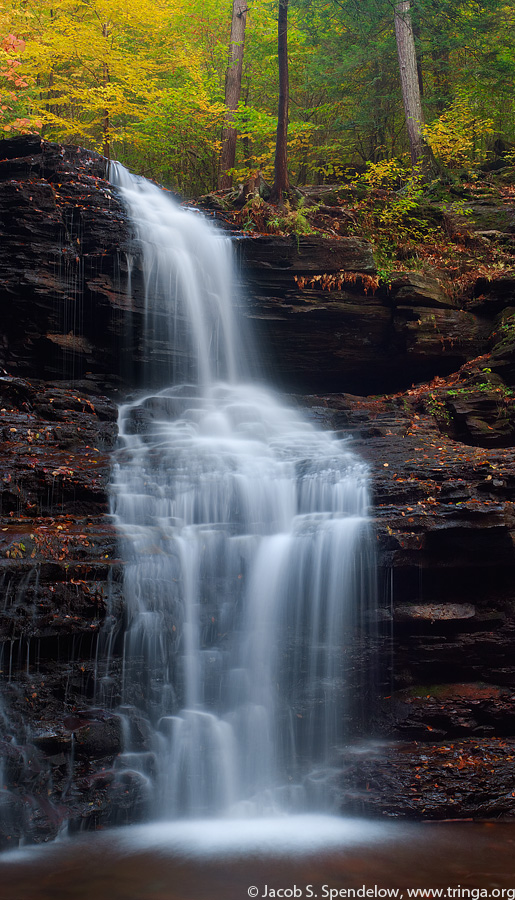
Water cascades down Shawnee Falls, one of ten named waterfalls in Ganoga Glen.
November 18, 2016 - Cape Cod
After more than twenty years of birding, I'm pretty familiar with most of the birds found on the North American continent. But the birds of the ocean are another story. Getting a good look at pelagic species such as shearwaters and storm petrels generally requires a long boat trip, which is not something I get to do on a regular basis. To me, these pelagic birds have long been enigmas, but a series of boat trips off Cape Cod in August and September provided a great opportunity for me to finally get to know these birds of the ocean better. I also enjoyed the opportunity to do some photography with buddies Josh Gahagan and Greg Schneider on these pelagic trips, as well as some of Josh's friends. Most of my photography is a solo endeavor, but it's always nice when I have a chance to shoot with other people who are passionate about birds.
Weather and sea conditions have to be just right for good pelagic birding and photography. Out of seven scheduled pelagics off of Cape Cod, two were canceled due to rough seas and several more ended up being fruitless efforts due to fog. But we had good luck with the weather on a few of the days, with sunny skies and glassy calm seas, allowing for some truly spectacular photo opportunities with a variety of seabirds. Numerous close encounters with Humpback Whales and a few Blue Sharks added to the excitement as well.

A Sooty Shearwater flies in front of breaching Humpback Whales.
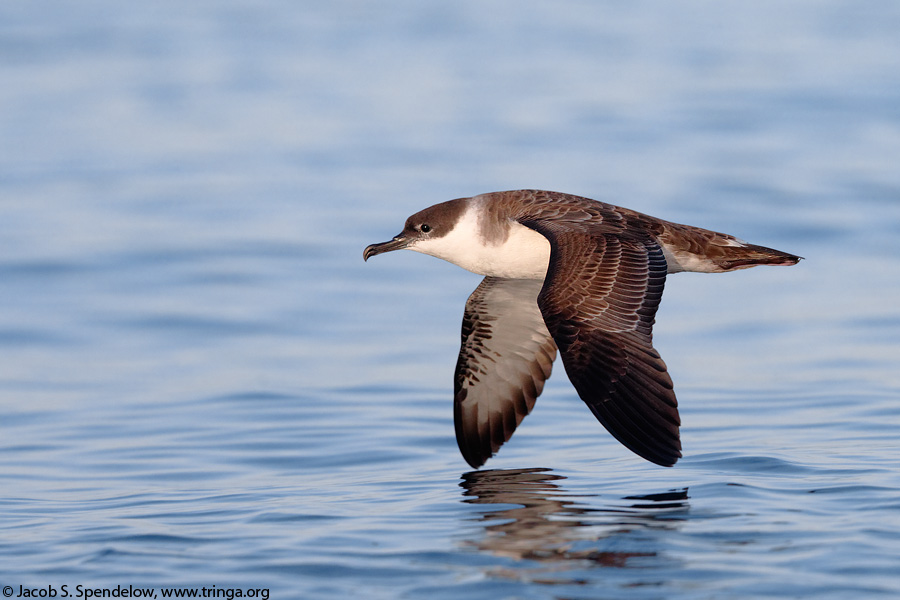
A Great Shearwater zips past just inches above the sea.
The first few trips were a mixed bag. We had good birds on some trips, but rough seas and fog limited the photo opportunities. The weather was perfect on one of the days, but the birds were nowhere to be found for most of the morning, and we didn't come upon a good flock until the sunlight was already getting a bit harsh for my tastes. We did get a few photos of birds and Humpback Whales that morning, but not nearly what I would have hoped for given how good the conditions were.
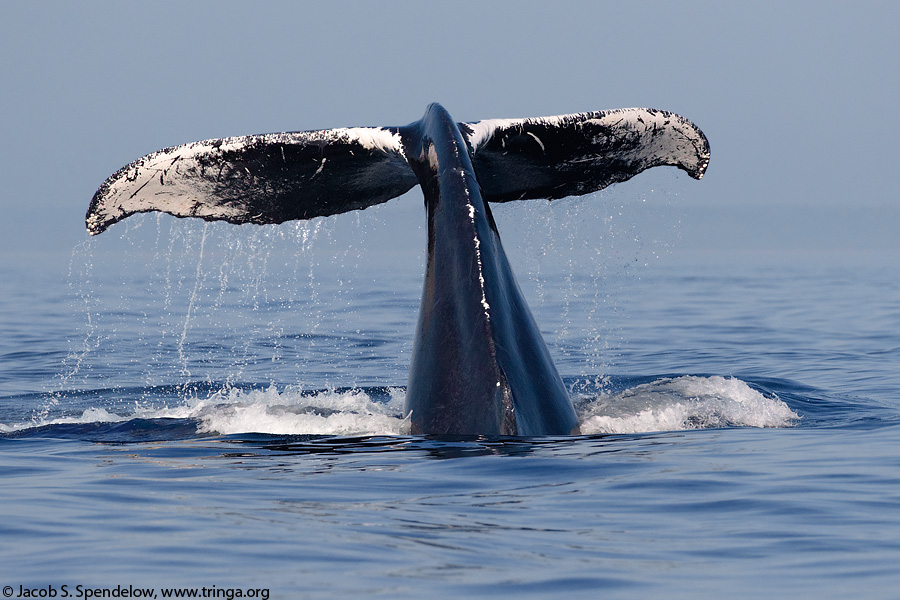
A Humpback Whale descends after breaching.
After struggling on some of the earlier trips, the final two trips in September ended up being the two most productive ones for my camera. It was obvious from the start that the second to last trip was going to be something special, as we sailed out into a beautiful sunrise over glassy calm waters with the full moon setting behind us. Birds were everywhere that morning, and Humpback Whales were out in force as well, with the flat seas making them easy to spot from a great distance. With the calm waters and complete lack of wind, the shearwaters weren't flying much, but they were relatively approachable on the water. We managed to coast up within photo range on a few occasions, and by leaning down over the railing as far as possible I was able to get some dreamy photos of resting Great and Sooty Shearwaters in sweet morning light.
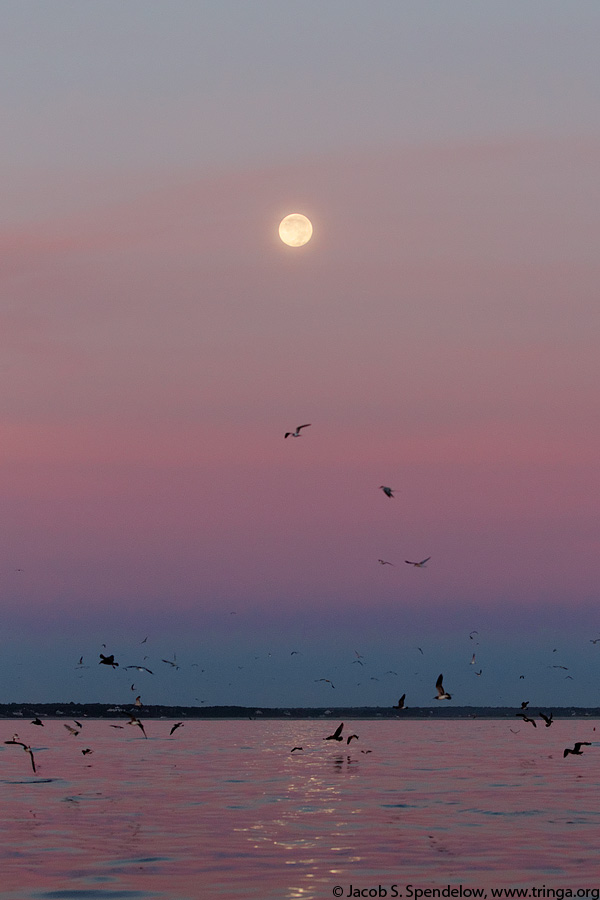
The full moon sinks toward the horizon before sunrise as we sail out for what would be a fantastic day of pelagic bird photography.
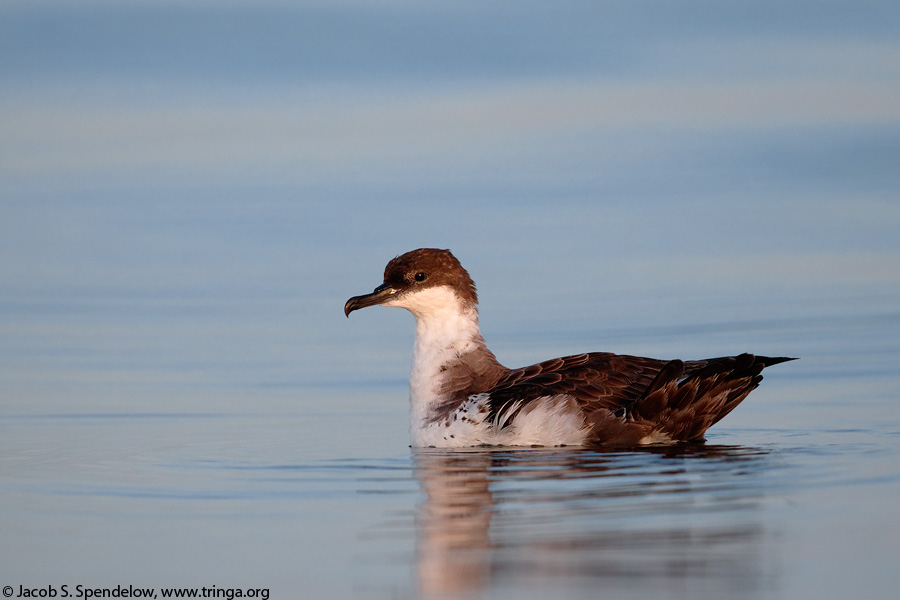
A Great Shearwater rests on glassy calm seas on a beautiful morning off Cape Cod.
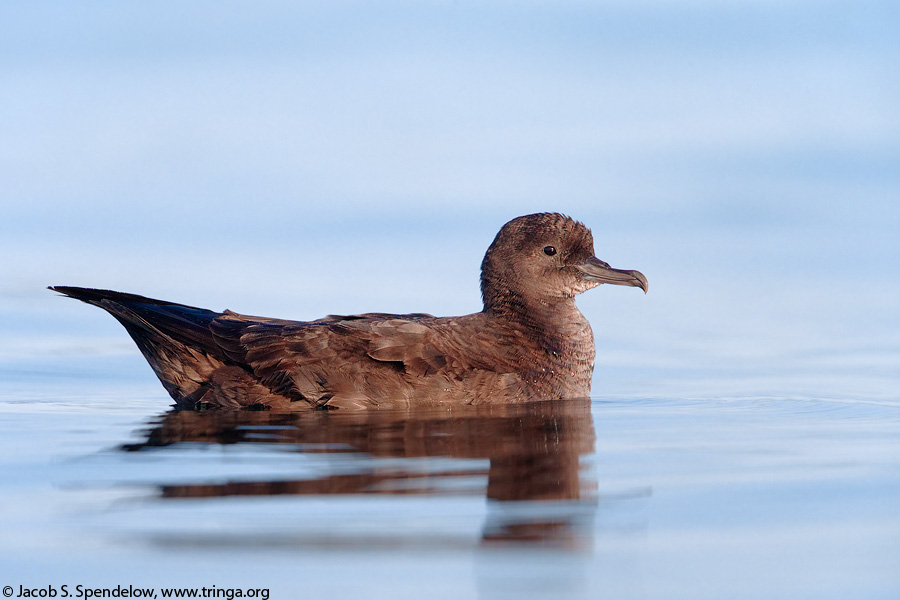
A Sooty Shearwater rests on the water. Sooties appear dark gray under most light conditions, but in early morning light they take on some warm chestnut tones.
My main targets on this trip were the four shearwater species typically found in New England. After the first few trips I already had plenty of good photos of Great, Sooty, and Cory's Shearwater, but the Manx Shearwater proved more difficult. The Manx were much shyer than the other shearwaters, and only rarely came anywhere near the boat. On the few occasions when one did make a close enough pass for a photo, the winds always seemed to be blowing the wrong way. This would cause the bird to bank away from the boat, making for a less than engaging photo. After struggling to get usable photos of Manx Shearwater on the first few trips, I made them my main focus on the later trips. It wasn't until the final trip, though, that I finally got the Manx Shearwater photos I'd been hoping for. Overcast skies and choppy seas almost caused us to cancel that trip, but once we were out on the water, things started to look better. The sky was mostly cloudy, but a gap on the eastern horizon allowed the sun to poke through right at sunrise, creating some spectacular lighting. We came upon a good flock of birds just as the sun rose above the ocean, and for a few magical minutes everything came together. For once, the winds and the sun were oriented just right for approaching birds to bank towards the boat, and for some reason the typically shy Manx Shearwaters suddenly started making close passes, the only time this happened on any of the trips. This incredible confluence of events lasted for only a few minutes, but many of my favorite photos came during that brief window.
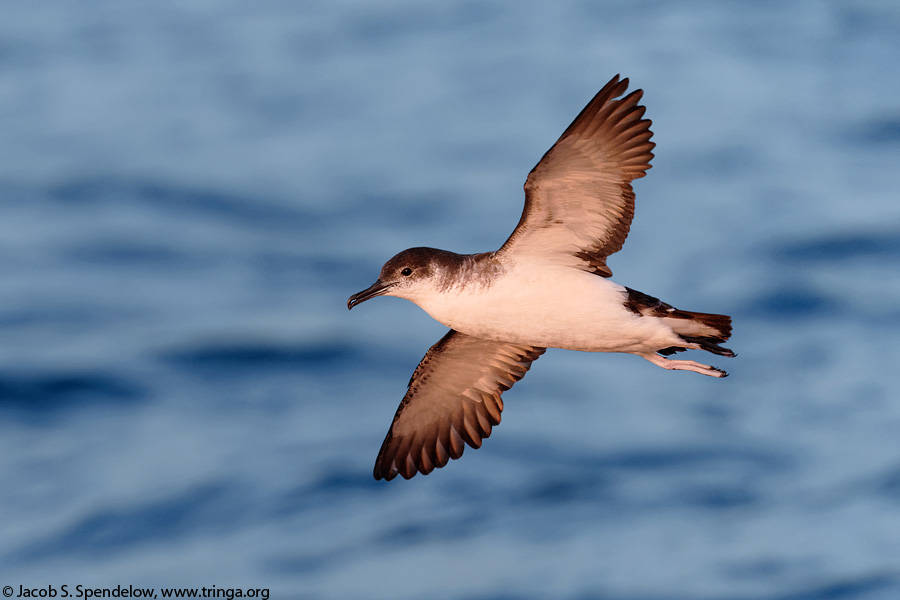
A Manx Shearwater banks past the boat in the sweetest morning light, just ten minutes after sunrise. Manx Shearwaters are the most difficult of the shearwaters found in New England, so getting this shot on our final pelagic trip was extra sweet.
My time on Cape Cod was mostly devoted to pelagics, but I also had one nice evening session of shorebird photography. It had been several years since I'd done any serious shorebird photography, so it was nice to get down and dirty again in a productive mud-crawling session with some of my favorite birds.
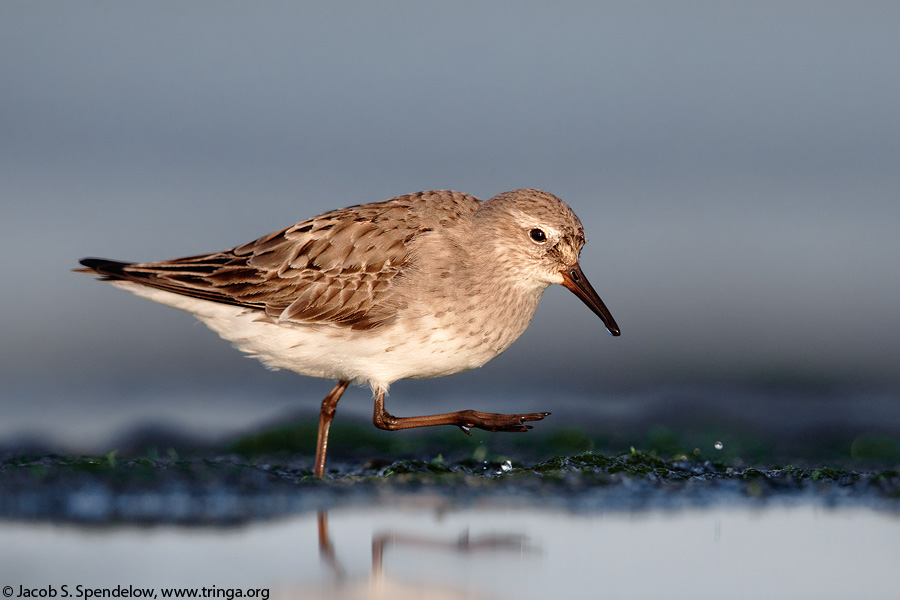
A White-rumped Sandpiper scampers across a mud flat on the shores of Cape Cod.
Now that my Cape Cod photos are posted, I'm completely up to date on bird photos. I'll have another gallery coming soon though, this one featuring fall colors and waterfalls from an October trip to Pennsylvania.
October 29, 2016 - Monsoon Hummingbirds
The late summer rains of the North American Monsoon bring the deserts of Arizona and New Mexico to life, with greenery and wildflowers springing up all around. The wildflower bloom attracts an impressive variety of hummingbirds, including some rarities from Mexico such as the beautiful Lucifer Hummingbird. A late August trip to Arizona, along with some early September photography in New Mexico, provided opportunities to capture photos of species ranging from the tiny Calliope Hummingbird (the smallest bird in north America) to the huge (for a hummingbird) Magnificent Hummingbird.
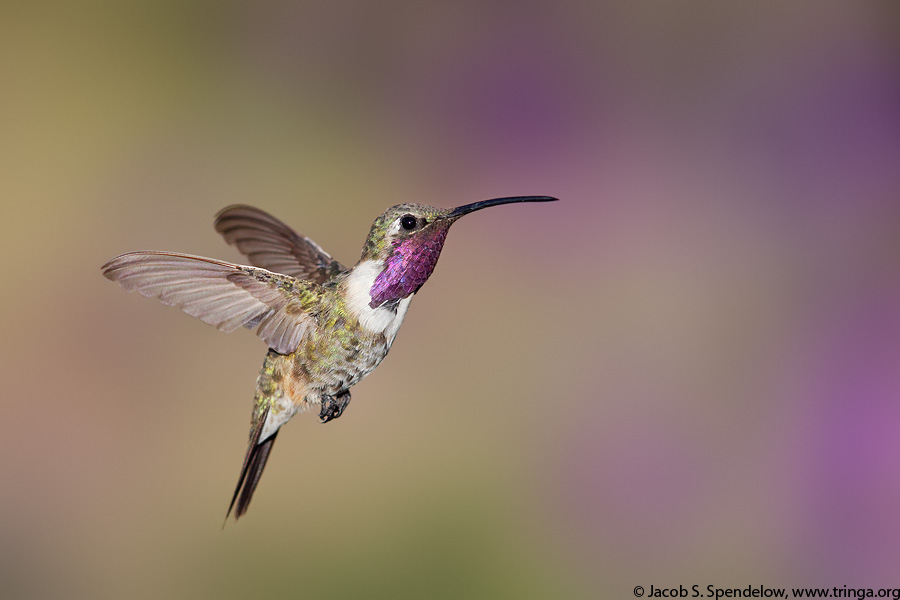
Most Lucifer Hummingbirds never leave Mexico, but the late summer wildflower bloom in Southeast Arizona entices a few to cross the border.
Most of my photography in late summer involved hummingbirds, but on the way back from my Arizona trip I had a lucky encounter with a Bendire's Thrasher, which is a rather difficult species to find, and even harder to identify, since it is almost identical to the much more common Curve-billed Thrasher.
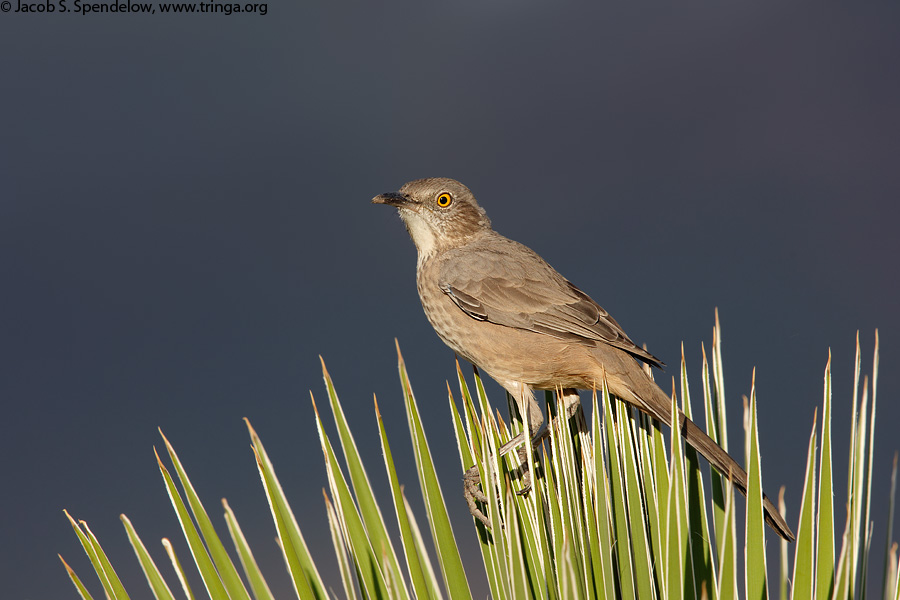
A Bendire's Thrasher perched on a yucca against a dark mountain background just before sunset.
October 27, 2016 - Michigan
The jack pine forests of Michigan's Lower Peninsula host almost the entire world population of the rare Kirtland's Warbler during the breeding season, with just a few individuals inhabiting similar forests in the Upper Peninsula and in Wisconsin. Since the warblers are most abundant and easiest to find in the northern parts of the Lower Peninsula, almost every serious North American birder at some point makes the pilgrimage to the area around Grayling and Mio to see this rare and endangered species. For me, that pilgrimage finally came this May, when I took advantage of a work trip to Detroit to add on a few days of warbler photography.
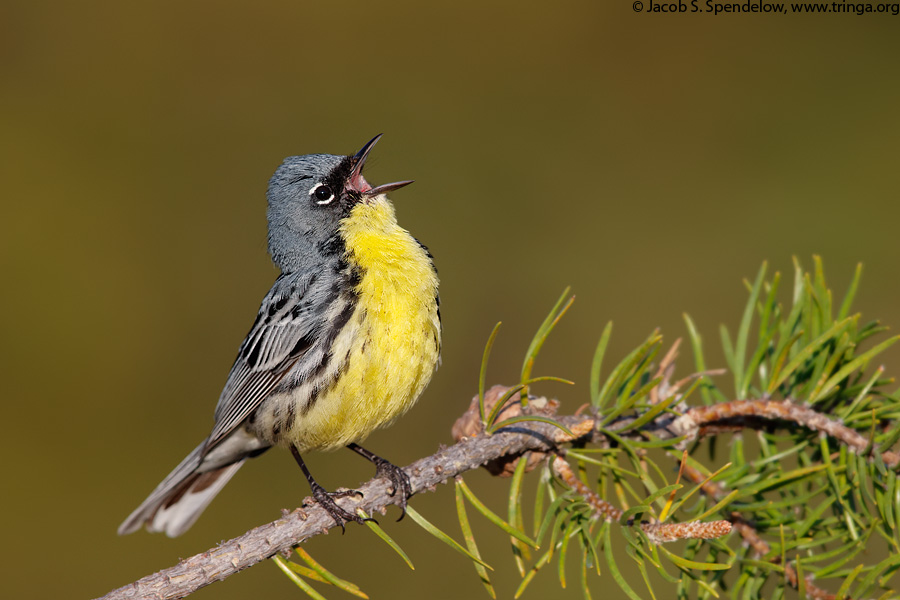
A Kirtland's Warbler sings from his perch on a young jack pine.
Though they are successful breeders in their favored habitat of young jack pine forests, changes in land use caused the Kirtland's Warbler to nearly go extinct in the 1970s and 80s. In addition to habitat loss, nest parasitism by Brown-headed Cowbirds, which expanded into the Kirtland's Warbler range when native forests were cleared for agriculture, further exacerbated the warbler's decline. Populations were reduced to a low count of 167 singing males in 1974 and again in 1987, but intensive management efforts led to a remarkable recovery beginning in the early 1990s. With counts of over 2,000 singing males in recent years, the Kirtland's Warbler recovery may soon be secure enough to remove the bird from the endangered species list.
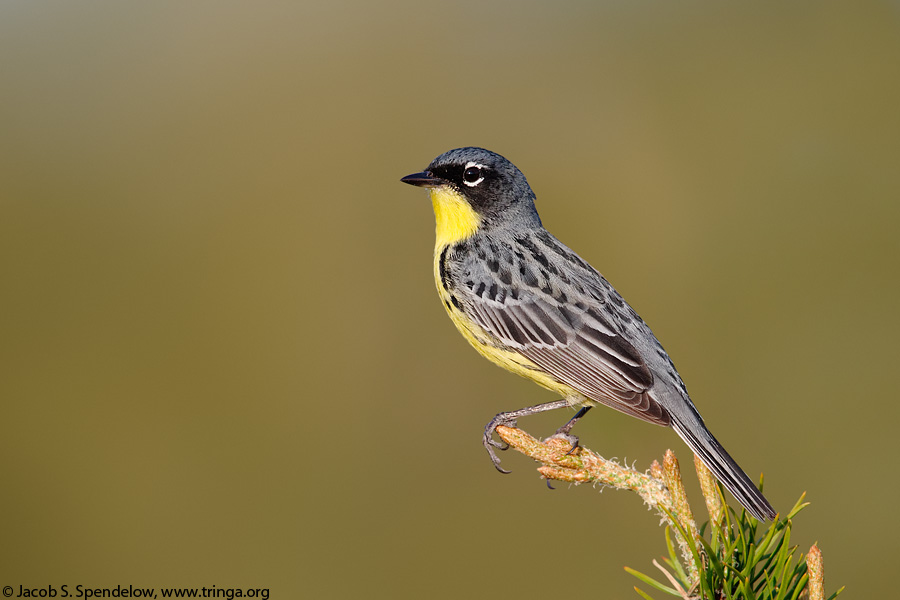
A Kirtland's Warbler perches atop a jack pine on a beautiful evening in late May.
Adding new warblers like the Kirtland's to my photo catalog is always fun, but it's going to be more challenging going forward since I now have photos of all the North American warblers that could reasonably be described as common. All that's left at this point is the rare Colima Warbler of the Big Bend area (less than 200 pairs), the Tropical Parula of the Lower Rio Grande Valley, and the rare and irregular Rufous-capped Warbler that is occasionally found in Arizona. I'll probably try for some of those guys in the coming years, but in the meantime, I could stand to improve on my meager images of some of the common New Mexico warblers like Virginia's and Black-throated Gray Warblers, so I'll probably focus more attention on those birds next spring.
October 24, 2016 - New Mexico
All of my photos from spring 2016 in New Mexico are now online. Most of my local shooting this spring involved grouse, and I already posted all those photos a few months ago, but the new gallery posted has the balance of my images. These are mostly from quick morning outings around Santa Fe and Los Alamos before work, but I did take one long weekend trip down to the Black Range and the Pinos Altos Mountains in the southern part of the state, where I finally got some photos of the unusual and distinctive Olive Warbler. The Olive Warbler was my biggest miss on my southwestern road trip in 2013, so getting some photos of this species has been one of my highest priorities since moving back to New Mexico. I'm glad to finally have a few photos, though of course I always want more!
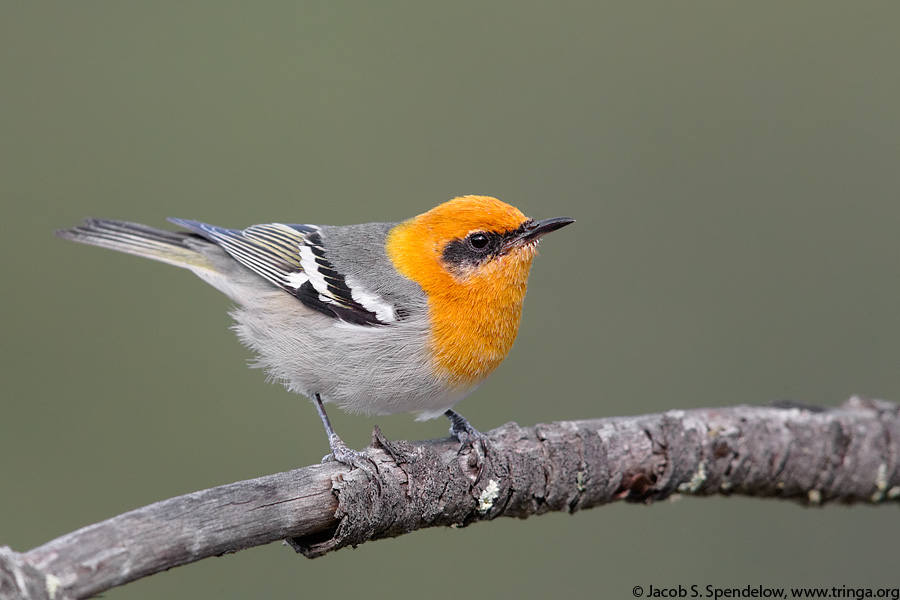
An Olive Warbler in the Pinos Altos Mountains of New Mexico. Despite the name, this species is not closely related to the wood warblers, or to any other songbirds.
Next up will be photos from a brief trip to Michigan in May.
September 26, 2016 - California
I traveled to California twice this spring for work, and on both trips I was able to add on a few days for photography. Although both trips were nominally to the San Francisco Bay Area, I ended up traveling widely, visiting locations ranging from the Channel Islands of Southern California to the Sierra Nevada of Northern California. Along the way I photographed a variety of bird species including California specialties like Island Scrub-Jay, California Gnatcatcher, and Yellow-billed Magpie.
The first trip was for a week in early March, and was originally intended to be devoted to photography in the San Francisco Bay Area. But bad weather caused a complete overhaul of my itinerary, and I ended up doing most of my photography much further south. Though it wasn't the trip I had planned on, it was nonetheless a great trip with many good photo opportunities.
Arriving in Oakland late at night, I headed out immediately to the redwood forest for some owling, hoping to finally find luck with my #1 nemesis, the Northern Saw-whet Owl. By my rough count, I've spent about twenty nights over the past three years wandering around in the dark in suitable habitat ranging from California to New Jersey looking for saw-whets. Unfortunately, I still don't have a single photo of that species. Though the saw-whets continued to elude me on this trip, I did have some great photo opportunities with Great Horned Owls that night. After looking for owls until well after midnight, I drove back down to check out some coastal marshes in search of an even tougher species: the enigmatic Black Rail. Though I heard several Black Rails that night, I wasn't able to see any, much less get a photo.
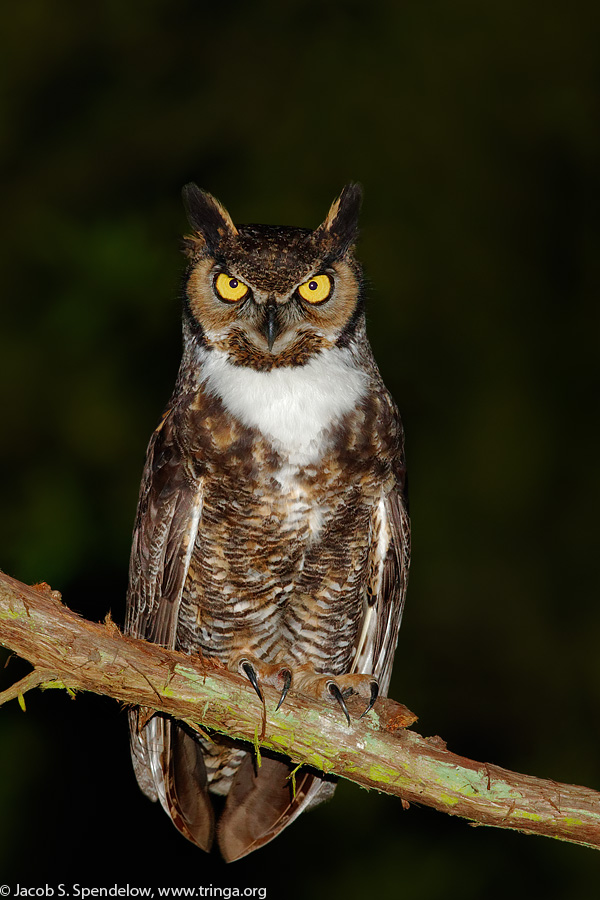
A Great Horned Owl in a Northern California redwood forest. Great Horned Owls show strong geographic variation in plumage, with birds of the wet Pacific Coast having a dark, sooty look to them.
After a few hours sleep, I woke up to drizzly gray skies, and the forecast called for more of the same for the next few days. I'd been eagerly looking forward to spending some time working on waterfowl, shorebirds, rails, and the like on this trip, but photographing in the rain is not much fun, and nobody wants to see bleak photos of soggy birds in weak gray light, so I had to find an alternative. After studying the forecasts and brushing up on bird distributions, I decided to drive down to Southern California to try for a few local specialties and hopefully find some better weather.
My first stop was Santa Cruz Island, one of the famous Channel Islands and the only home of the endemic Island Scrub-Jay. I'd seen the jays of Santa Cruz many years earlier on a birding trip, but this would be my first opportunity to point a camera at one. Despite a decent forecast, the weather on the islands ended up being pretty bad that first day. I had to deal with continuous drizzle and weak murky light, but I did get a few photos of damp Island Scrub-Jays, so they will have to do for now. I also got to photograph an Island Fox, an endemic species descended from the Gray Foxes of the mainland.
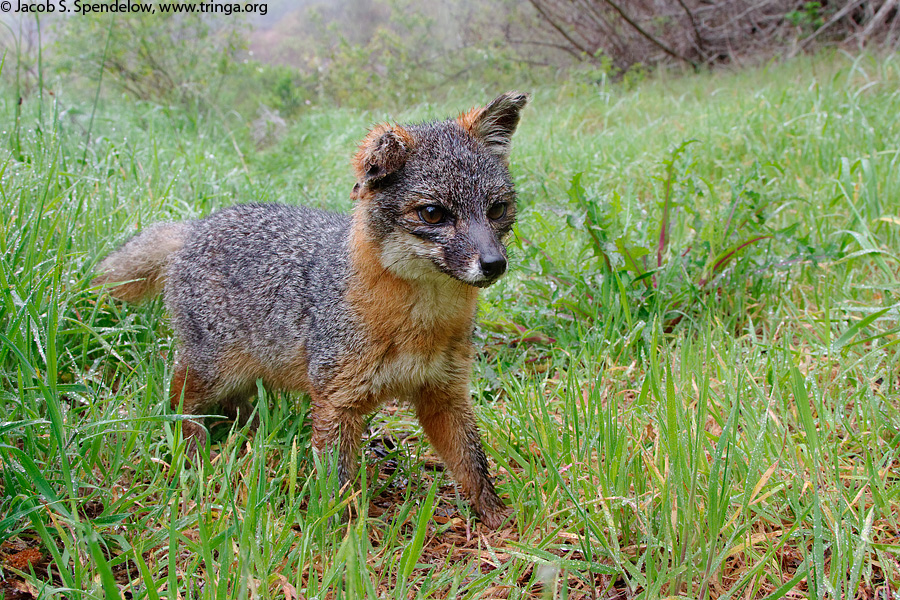
The Island Fox is found nowhere on earth except for the Channel Islands. Descendents of Gray Foxes that made their way to the Channel Islands during the last ice age, Island Foxes are a relatively new species, but the habitat constraints of the islands have caused them to evolve rapidly away from their more cosmopolitan ancestors.
The next day I continued on south to the LA area, where my main target was the California Gnatcatcher. California Gnatcatchers inhabit brushy chaparral and are mainly found in coastal areas of Southern California and Baja California. They are rare and threatened due to habitat loss, but in the few places where good habitat remains the gnatcatchers are not difficult to find. I was lucky enough to finally have good weather first thing in the morning, and was able to grab a few good photos of the gnatcatchers before the winds picked up and the clouds rolled in.
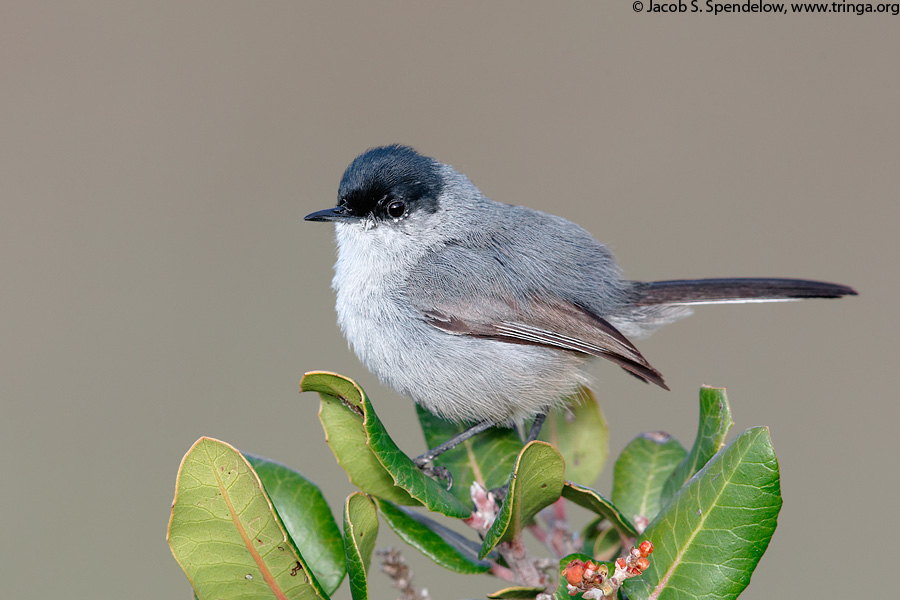
The California Gnatcatcher is a highly threatened species. Though still easy to find in appropriate habitat, the coastal bluff habitat that they call home has mostly been destroyed by developers.
Heading back north again, I decided to stop for a day in the mixed meadows and oak woodlands of the Salinas Valley in search of some California specialties like Yellow-billed Magpie and Oak Titmouse. Yellow-billed Magpies are endemic to California, and Oak Titmice nearly endemic, with just a few border populations spilling over into neighboring states. I ended up having some great photo opportunities with both species, and also got to photograph some California Scrub-Jays, which were recently split from Western Scrub-Jay and elevated to full species status.
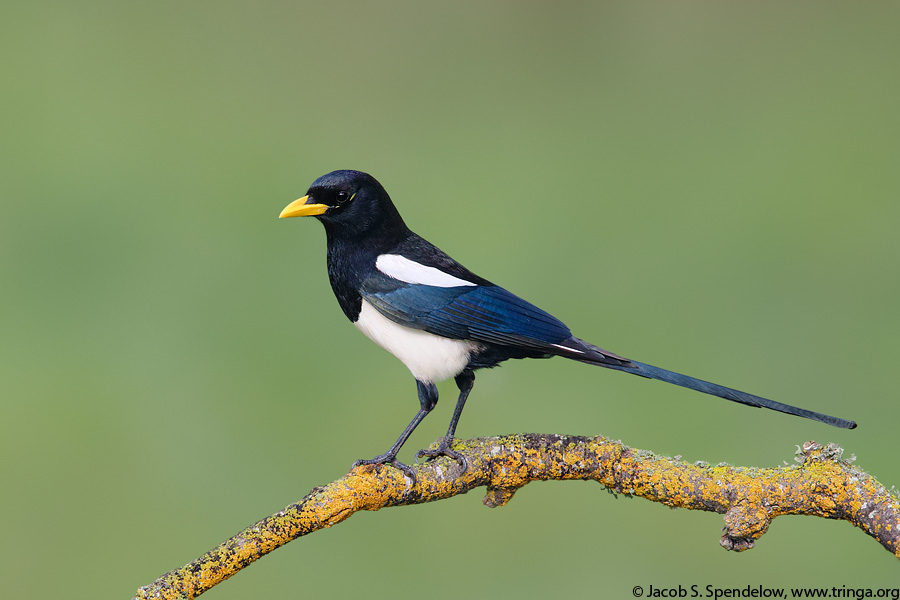
A Yellow-billed Magpie perches on a lichen-covered oak branch.
After a good swing through the southern and central parts of the state, I returned to the Bay Area, where I had a few days of experiments scheduled at Stanford University for my real job. I was able to get some photo time in during the mornings, though, and did have one nice sunny morning by the bay in which I got to photograph several species of waterfowl as well as a few Ridgway's Rails.
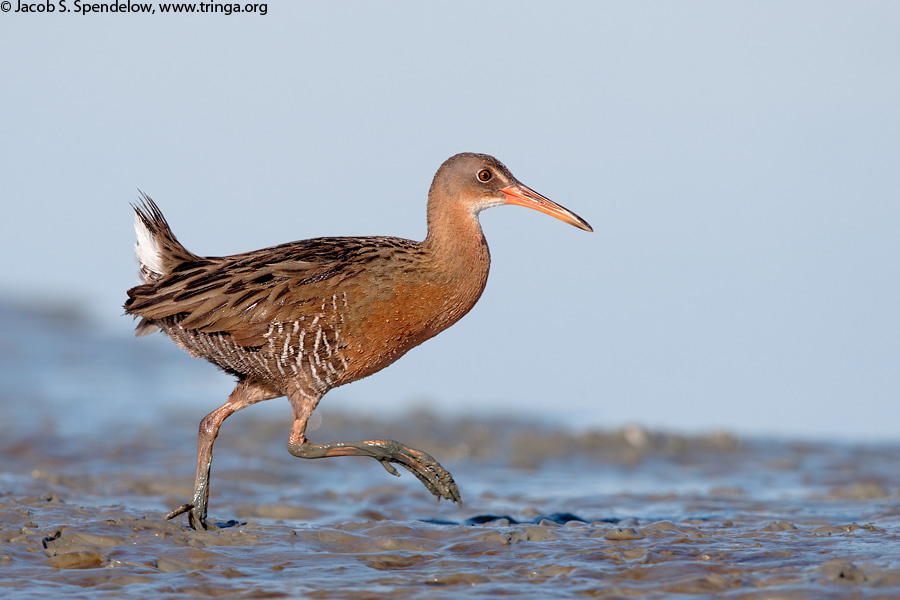
A Ridgway's Rail scampers across a Northern California salt marsh. Though considered a subspecies of Clapper Rail until recently, genetic analysis has revealed that this distinctive species is actually more closely related to the King Rail.
I had a few more days to spend on photography after finishing my work at Stanford, but was again faced with a forecast for almost continuous rain the next few days. With no realistic opportunities in the Bay Area, I again headed south, revisiting some of my favorite spots from the previous weekend in the Salinas Valley. After getting a few more shots of local specialties like Oak Titmouse and Nuttall's Woodpecker, I reluctantly headed back to Oakland for my flight home.
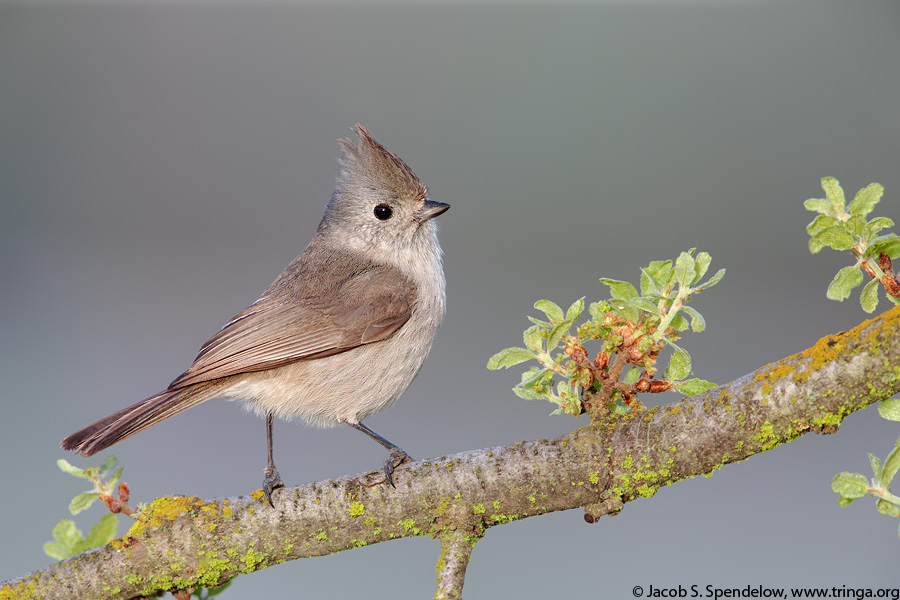
An Oak Titmouse photographed just minutes after sunrise on a misty morning in the Salinas Valley. Foggy conditions tend to be challenging for bird photography, but I was lucky enough to have the mist part in front of this bird for just a moment while still giving a dreamy look to the background.
It wouldn't be long before I got another chance to visit the Bay Area, though. Heading out for a full week of meetings in Berkeley in early May, I again arranged my trip to allow for a few days of photography, but this time I was more focused on the recently-arrived breeders of the area. Two birds near the top of my most wanted list were the gorgeous Hermit Warbler and the charming Cassin's Vireo, and seeing that they were more common in the mountains, I decided to spend some time up in the Sierra Nevada. The weather wasn't great up there either, with drizzle and mist for most of the weekend, but the photo opportunities were pretty good. A little flash goes a long way toward improving the lighting with small songbirds (much more so than for waterbirds).
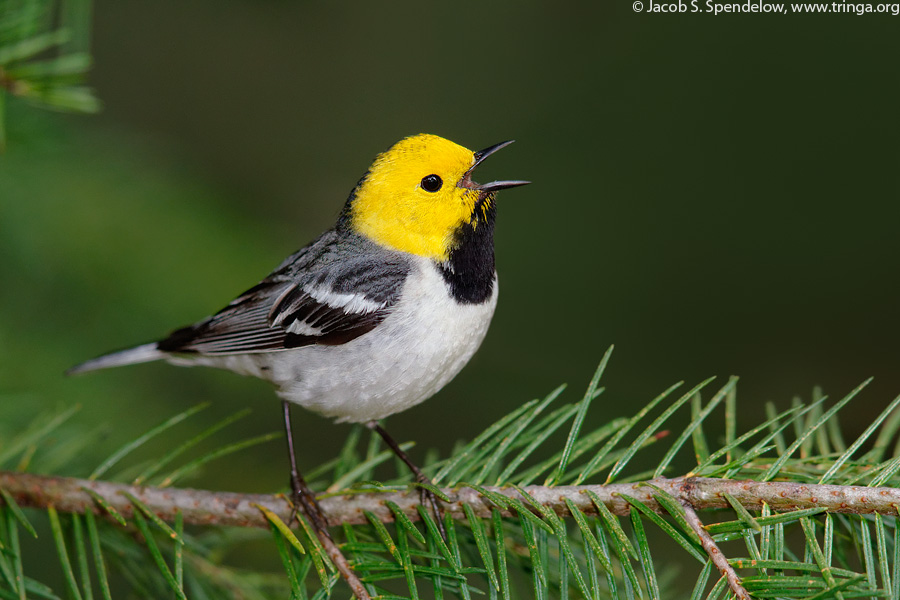
A brilliant little Hermit Warbler sings away in a Northern California fir forest.
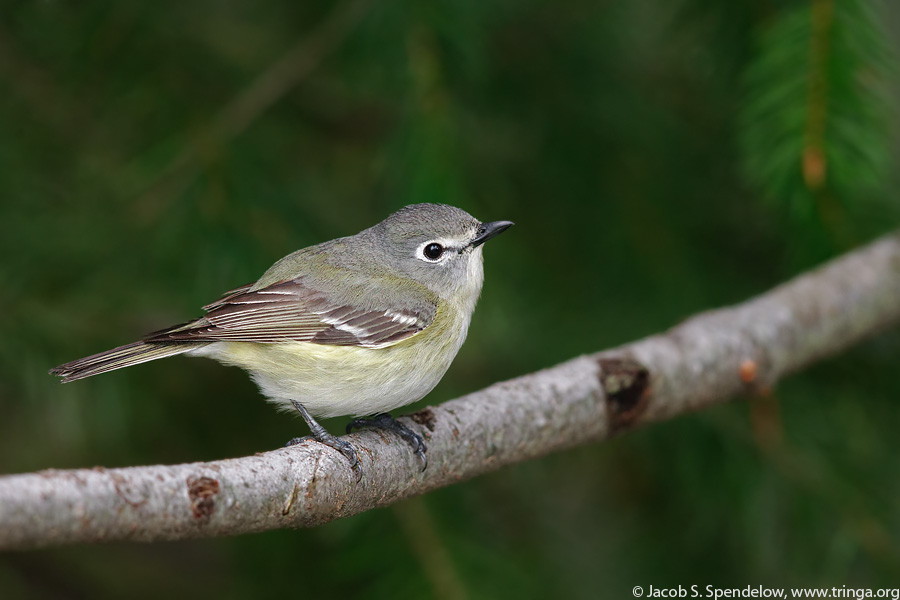
A Cassin's Vireo on a fir branch in the misty forests of the Sierra Nevada. This was the only North American vireo I hadn't photographed prior to this trip, so I was extra happy to finally get some photos of this species.
After getting some nice photos of my target warbler and vireo, it was time to head back to Berkeley. I was pretty busy with work that week, and wasn't able to stay for the following weekend, but I did still have one target bird I still really wanted to photograph: the Pacific-slope Flycatcher. Though I didn't have much time available to search, the local parks right around Berkeley turned out to be loaded with Pacific-slope Flycatchers, and I was able to squeeze in a few early morning sessions with that species before work.
Getting to do some serious photography in California has been one of the highlights of my year so far, and with luck, I may have another opportunity soon. With another work trip to Berkeley tentatively scheduled for early December, I'll be keeping my fingers crossed for good weather and some opportunities to finally get the waterfowl and shorebird shots I've been dreaming of.
August 21, 2016 - Arizona
I was in Phoenix for a day and half this spring and took the opportunity to head out to natural areas near the city for a bit of photography. My main goal was to get photos of Gilded Flicker, a species I have seen only a few times and barely know. After succeeding in getting a few flicker shots, I visited some wetland areas to photograph lingering waterfowl.
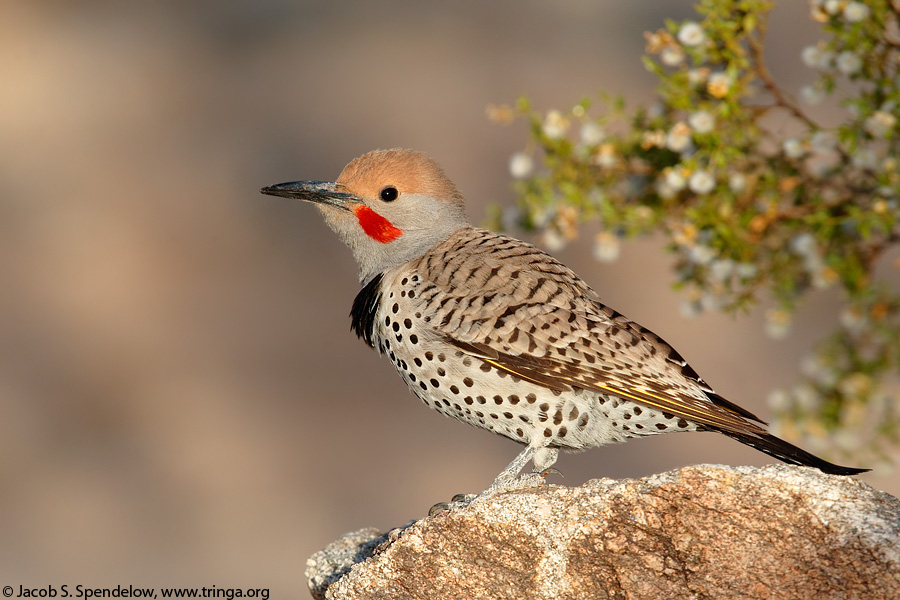
Although I got a few photos of Gilded Flickers on Saguaros, the flickers actually spent more time on the ground and on rocky outcrops. Like the more familiar Northern Flicker, the Gilded Flicker is an unusally terrestrial woodpecker.
Much of the wintering waterfowl had already left the area, but I found a few remaining Ring-necked Ducks, Redheads, and Ruddy Ducks. I was happy to finally have an opportunity to photograph Ruddy Ducks in high breeding plumage with nice light, something I've been dreaming of for years. I also checked out a few city parks around Phoenix until I found some Rosy-faced Lovebirds, an exotic species that has become firmly established in the area.
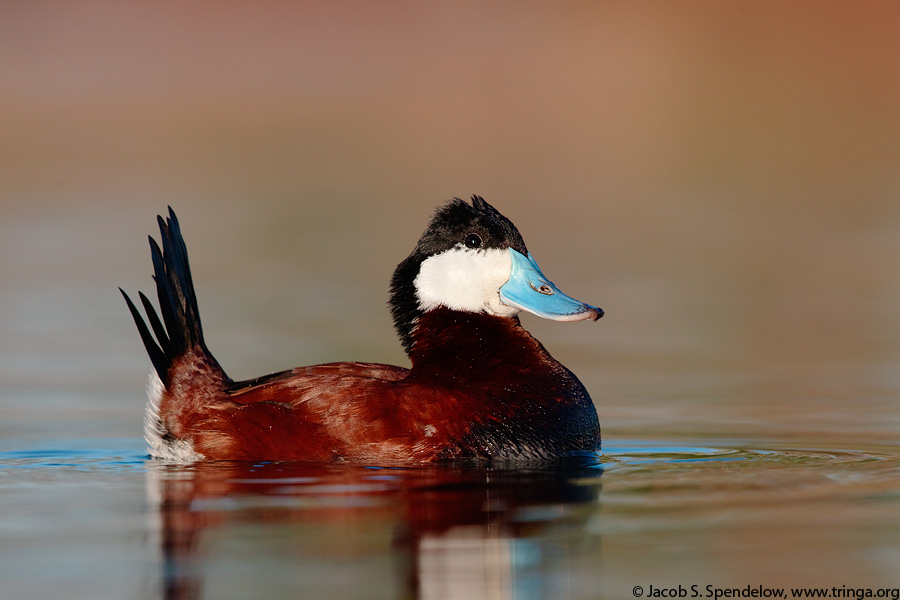
A male Ruddy Duck in pristine breeding plumage. Ruddy Ducks acquire their breeding plumage later in the season than most other ducks species, and since I do most of my waterfowl photography in winter I rarely get to see this plumage.
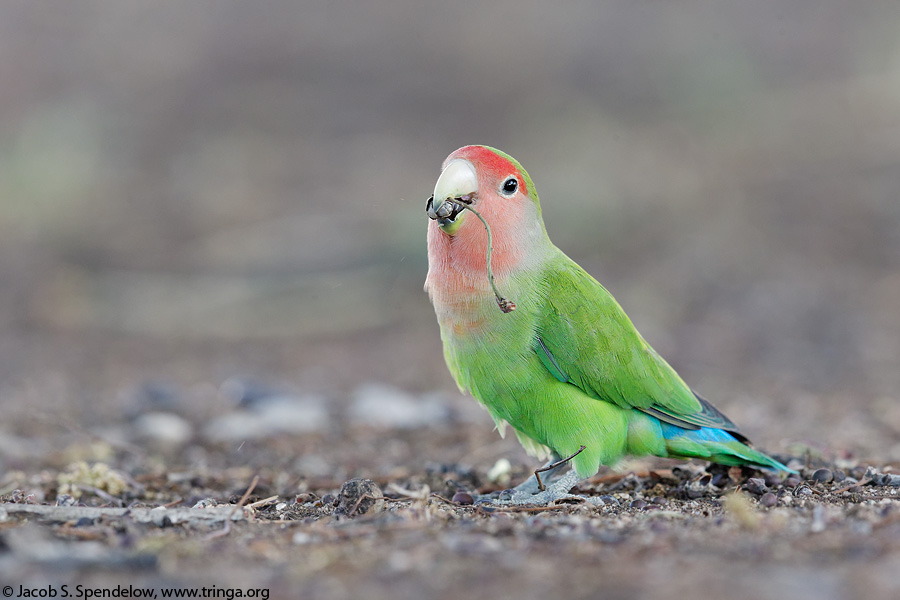
Rosy-faced Lovebirds were introduced to Phoenix in the 1980s and have successfully adapted to the urban parks of the area.
I'm slowly catching up on my photos, but still have many more to come from this spring, as well as some pelagic photos from a recent trip to New England.
July 18, 2016 - South Texas
I paid a brief visit to South Texas back in February, starting with a morning at Aransas National Wildlife Refuge. Aransas is well known as the wintering grounds of the only wild Whooping Crane flock, and a boat tour of the refuge provided a few brief photo ops with the cranes.

A Whooping Crane flies over the coastal marshes of Aransas National Wildlife Refuge.
Next I headed down to the Lower Rio Grande Valley, one of the best birding areas in North America and an area I try to visit at least once every few years. I spent three days in the valley, photographing some of the area specialties like Audubon's Oriole and Green Jay. I also enjoyed some nightbirding, getting photos of Great Horned Owl and Common Pauraque. I also saw a few Barn Owls and Eastern-Screech Owls, though those guys didn't cooperate for my camera.
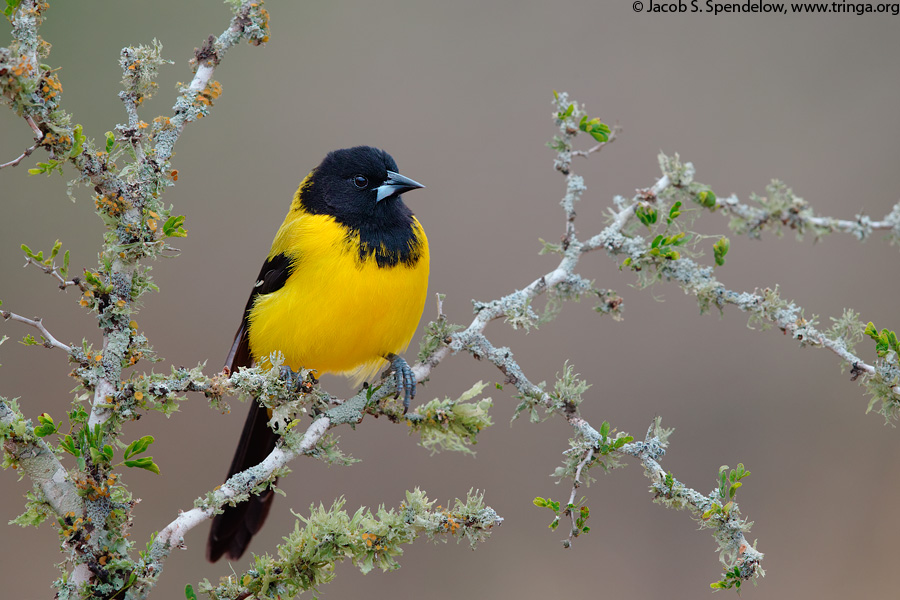
An Audubon's Oriole on a lichen-covered blackbrush acacia.
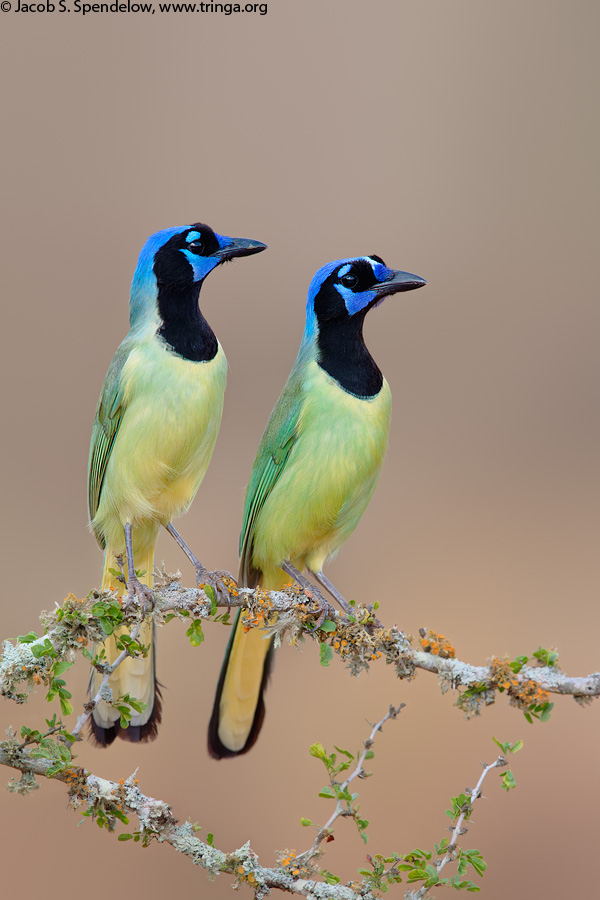
Green Jays are social birds, moving through the Tamaulipan thornscrub of South Texas in small, noisy flocks.
Next up I will be working on photos from a brief trip to Arizona in early spring. Also to come are many photos from this spring in California, Michigan, and New Mexico.
May 31, 2016 - Grouse Leks
Every morning in early spring, a strange ritual occurs at select locations on the short grass prairie and sagebrush steppe of Colorado and neighboring states. Long before dawn, male grouse begin emerging onto traditional lek sites, where they strut, dance, display, and sometimes fight with other males, all in an effort to demonstrate status and attract a mate. The sites of these leks are the same year after year, and the grouse can predictably be found there throughout the early morning hours, so these leks can be great sites for photography. I spent much of late March and April traveling through the sagebrush and grasslands of Colorado and New Mexico, photographing at the leks of four different grouse species.
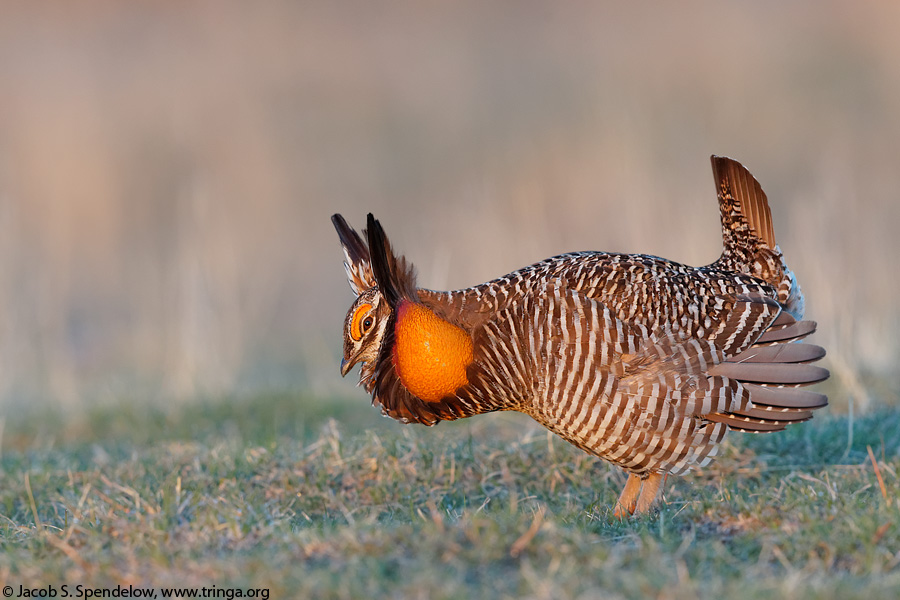
A Greater Prairie-Chicken in full display.
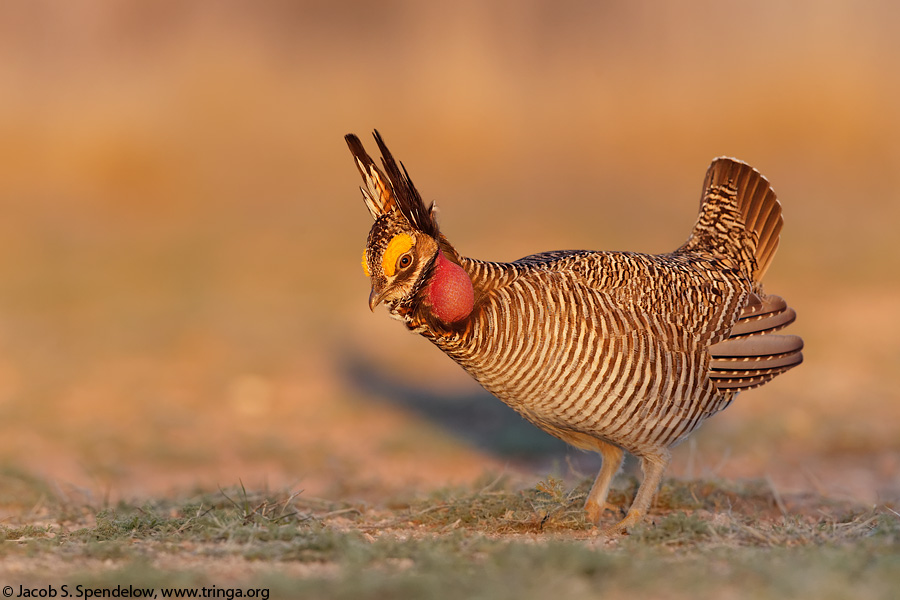
A Lesser Prairie-Chicken displays on a lek at sunrise.
Lek behavior varies from species to species, but generally involves an intricate dance that climaxes with the sudden inflation of brightly colored air sacs on the neck or breast, producing a strange music and bizarre visual display.
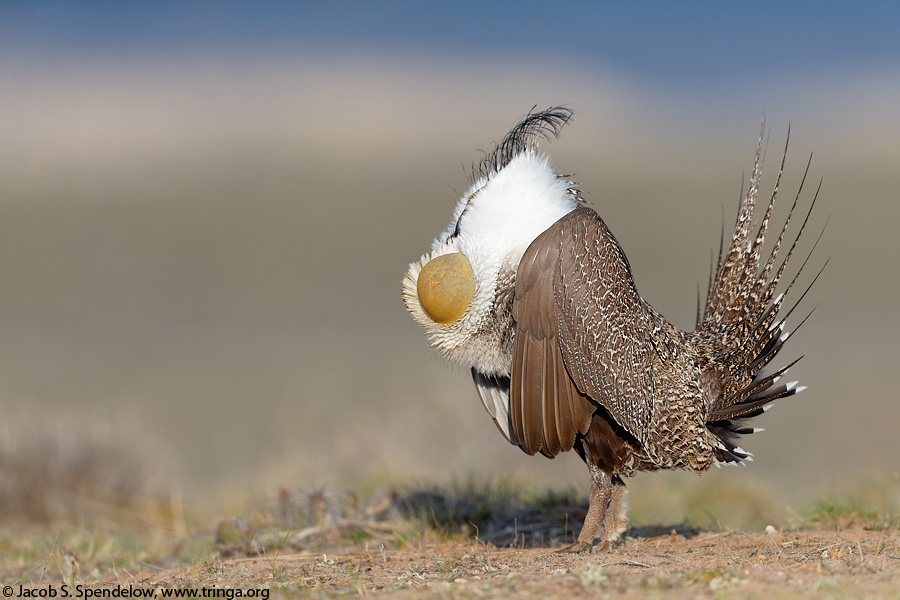
This male Greater Sage-Grouse is inflating the yellow air sacs on his chest, part of a dance intended to intimidate other males and impress females.
While some leks may attract dozens or even hundreds of male grouse, very few of these grouse are able to mate. On a typical lek, one or two males establish their dominance over the other males, and female visitors to the lek usually breed only with the highest status males. Visits by females are infrequent, so when a hen does show up on the lek, the male grouse go into a dancing frenzy, and sometimes attack other males to prevent them from mating with her.
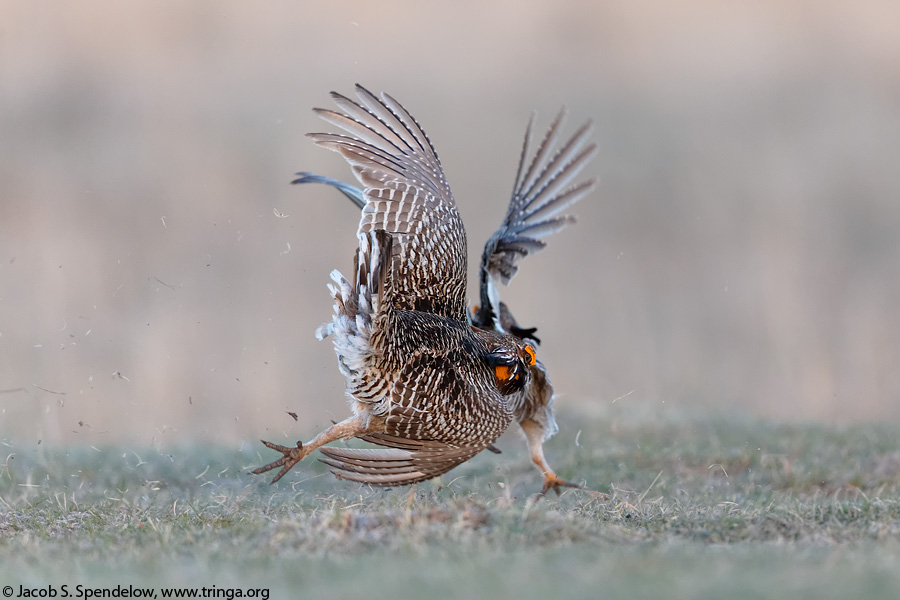
Greater Prairie-Chickens battle to establish their dominance on the lek.
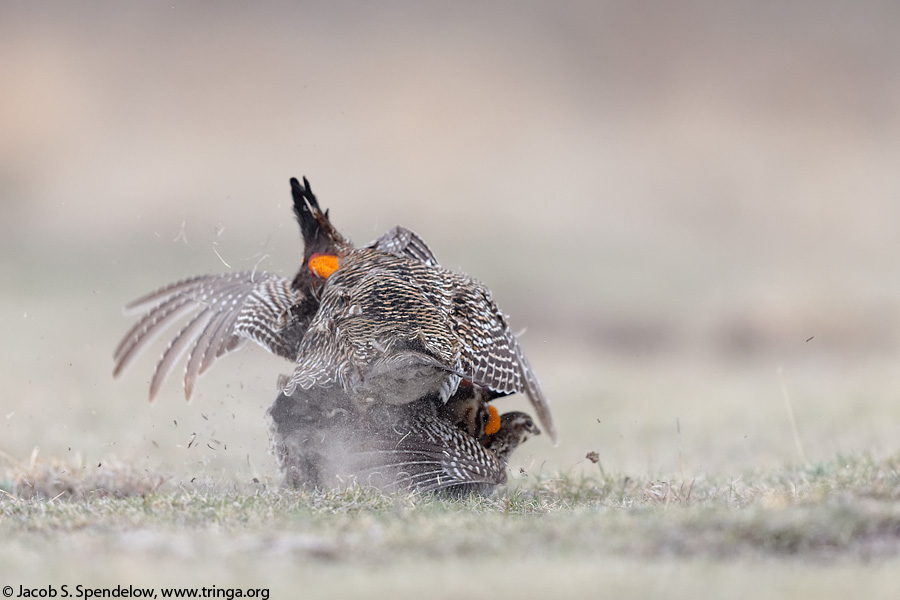
This particular Greater Prairie-Chicken lek featured two males that both considered themselves king of the lek. When a hen arrived on the lek and allowed one of the males to mate with her, the other male attacked. The full series of photos can be viewed here.
Grouse were the main focus of my trips through the sagebrush and grasslands this year, but I also had opportunities to photograph a variety of songbirds, raptors, owls, and other birds along the way. Highlights included getting to photograph Burrowing Owls during both day and night, a Swainson's Hawk pair engaged in nest building, and a lovely Sagebrush Sparrow that was singing right next to a Greater Sage-Grouse lek.
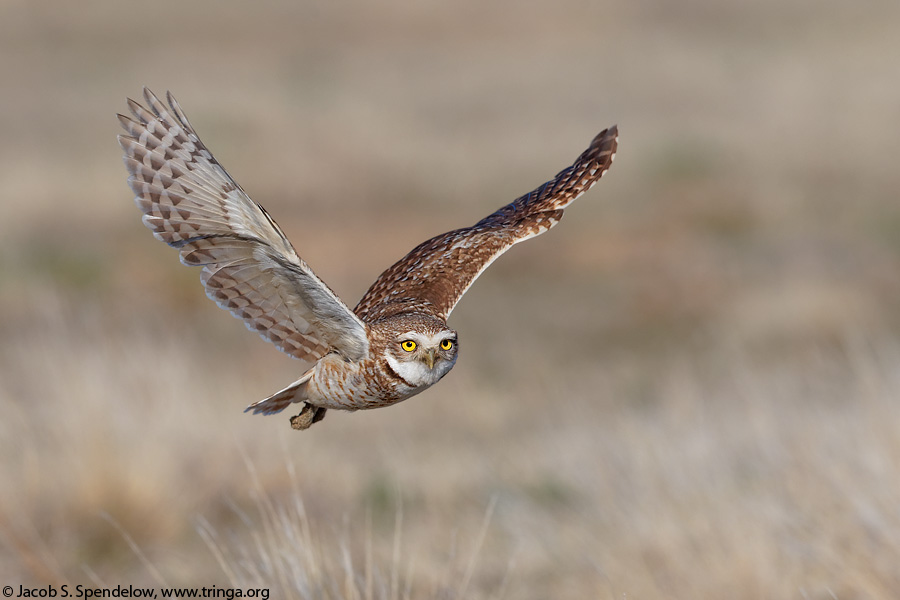
A Burrowing Owl flies through a prairie dog town.
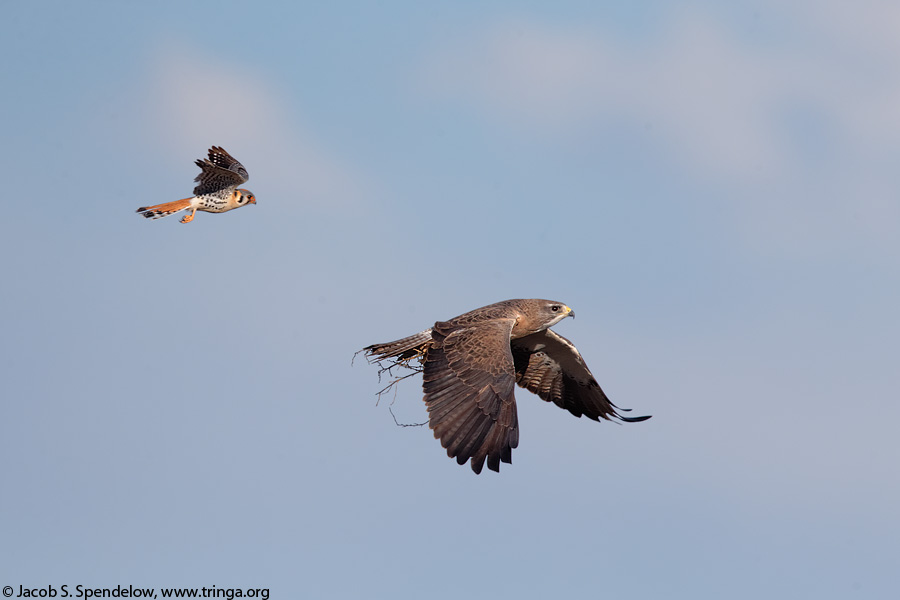
An American Kestrel with a nest nearby tries to discourage a Swainson's Hawk from nesting in the same grove. On the great plains, any woodlot is a highly valued nesting spot.
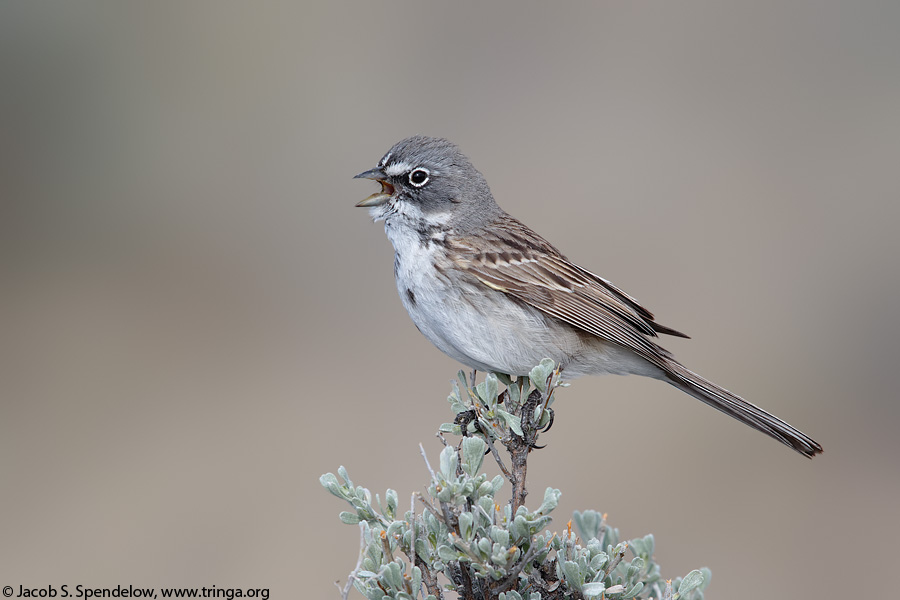
A Sagebrush Sparrow belts out his song on a beautiful morning in Colorado's sagebrush steppe.
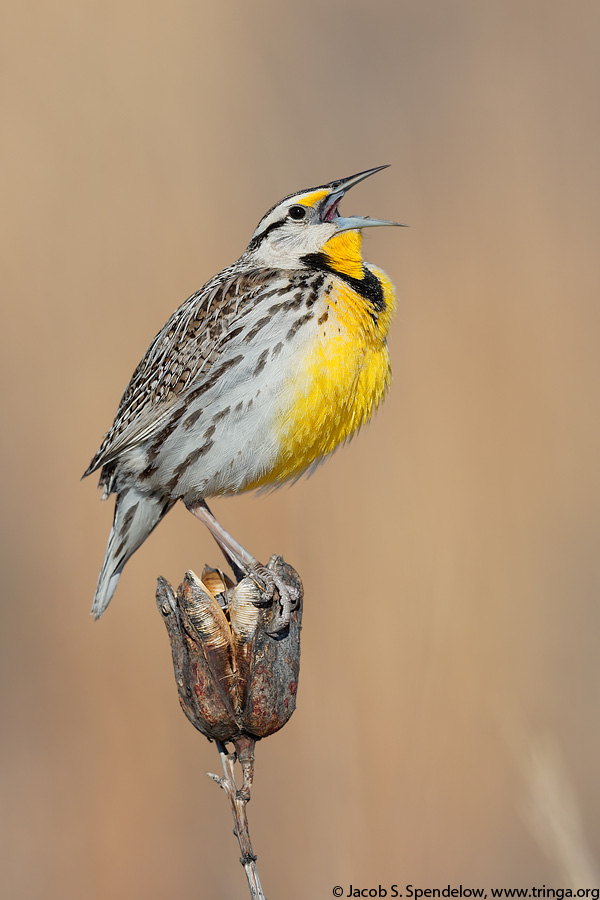
The "Lilian's" Eastern Meadowlark of the desert southwest is noticeably paler than the typical Eastern Meadowlarks found farther east. Some authorities have suggested that it is a separate species, and it is a likely candidate for a future split.
April 19, 2016 - Arizona
Photos from a brief trip to Arizona in late December are now online. I was targeting a few rarities that were wintering in the area - Sinaloa Wren, Rufous-capped Warbler, Rufous-backed Robin, and Streak-backed Oriole - but I was only able to get photos of the robin and the oriole. Even those guys didn't really cooperate, so the photos aren't quite what I'd hoped for. I've never been a fan of chasing rarities, and this trip certainly reinforced my feelings on the subject. I did better with some of the more typical birds like Arizona Woodpecker and Mexican Jay, and if I could do the trip again I think I would focus more on those guys than the rarities.
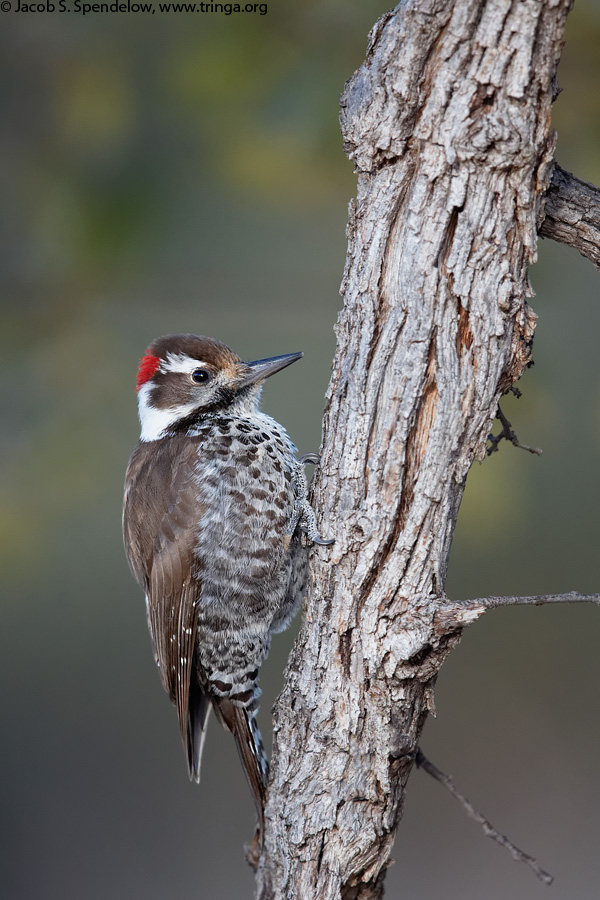
An Arizona Woodpecker, one of the typical birds of the Madrean pine-oak woodlands of Southeast Arizona, perches on an oak snag.
March 2, 2016 - my photo appears at the Senate!
I'm very late to post this, but here's a cool video from the Senate floor last year, where Senator Tom Udall of New Mexico gave a great speech about protecting Lesser Prairie-Chickens. One of my prairie-chicken photos makes an appearance at the 45 second mark!
Here's the original posting on c-span: http://www.c-span.org/video/?c4525693/sen-tom-udall-discusses-lesser-prairie-chicken
Here's the original photo: Lesser Prairie-Chicken
March 2, 2016 - England and Costa Rica
Photos from two international trips in January are now posted. The first trip was a vacation in Costa Rica, most of which I spent surfing and scuba diving, but I did take a few bird photos while I was there.
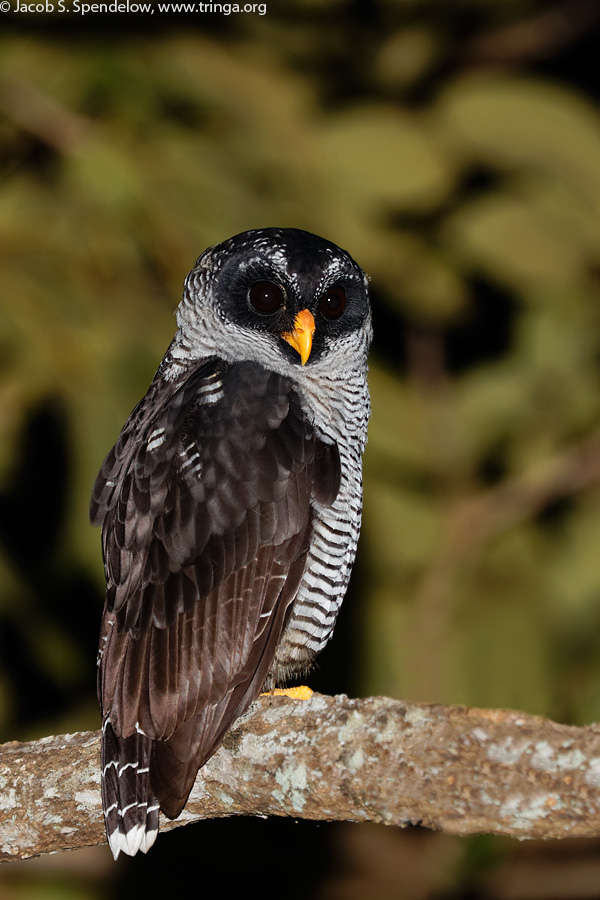
A Black-and-white Owl in Costa Rica.
The next trip was a work trip to England, where I spent a few days doing experiments at the National Physical Laboratory in London. I was able to head out to local parks and do some photography on several mornings, and was lucky enough to have some spectacularly sunny sessions at a local duck pond.
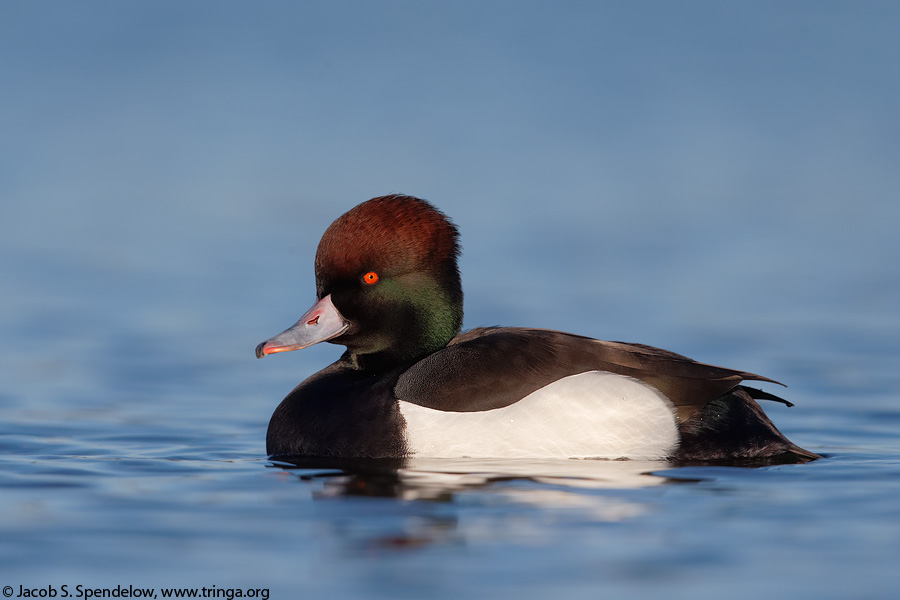
This very interesting duck that I found on a pond at Bushy Park appears to be a hybrid between a Red-crested Pochard and a Tufted Duck.
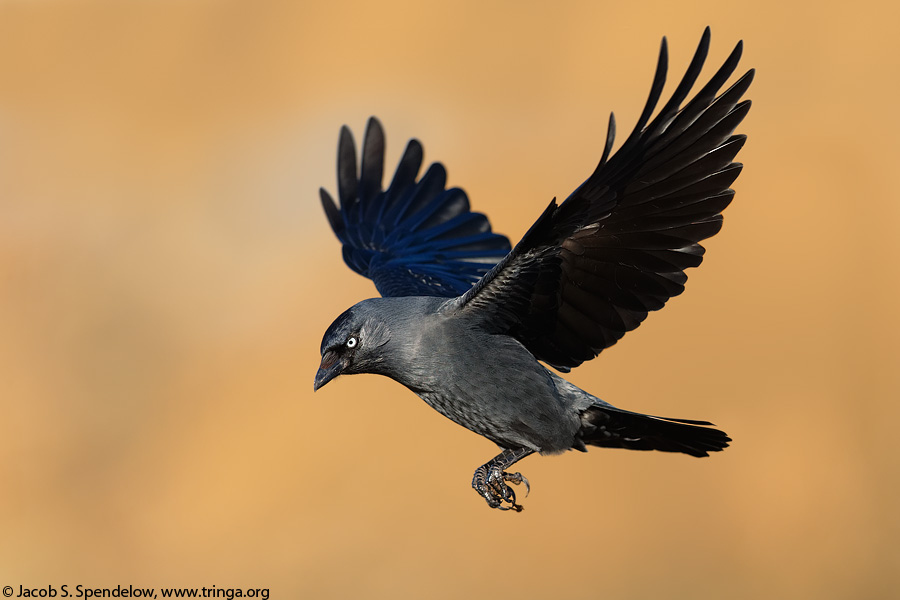
A Eurasian Jackdaw in flight.
February 25, 2016 - Newfoundland
I spent a week exploring Newfoundland for the first time last July, and spent most of my time photographing the abundant seabirds that breed in several colonies on the southeastern part of the island. I also spent some time in the boreal forests and tundra areas, and even took my kayak out onto the ocean a few times to get photos of puffins and other alcids on the water.
I visited several seabird colonies on this trip, but my favorite by far was the Northern Gannet colony at Cape St. Mary's. It's about the easiest place to photograph imaginable, since the birds are all over a rock right in front of the viewing area, and are constantly flying in and out of the colony. What's more, the scenery in that area is spectacular, with great bluffs rising high above the sea and miles of beautiful tundra stretching off as far as the eye can see. There were also a variety of boreal songbirds inhabiting a few patches of stunted trees, which I guess pass for boreal forest in that windswept area.
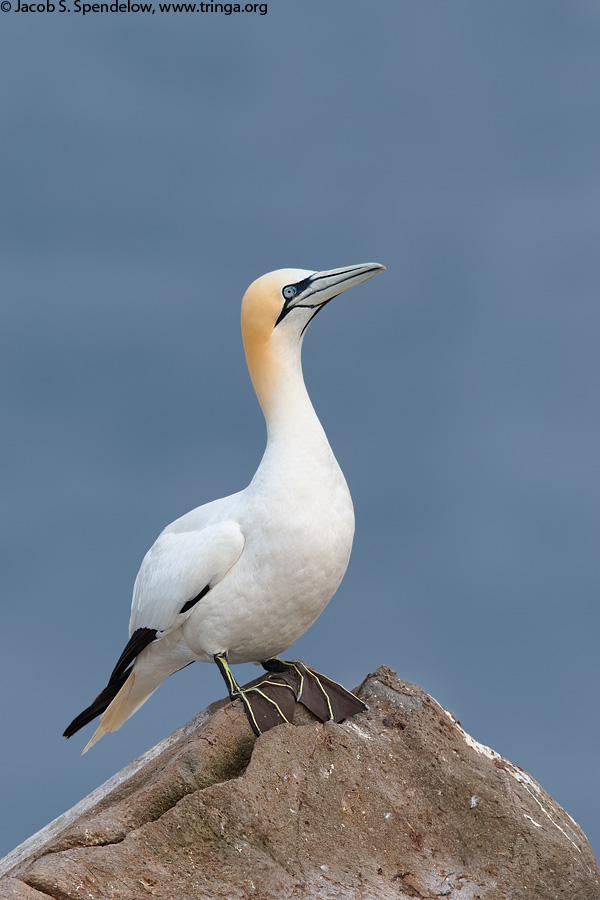
A Northern Gannet at the Cape St. Mary's Colony.
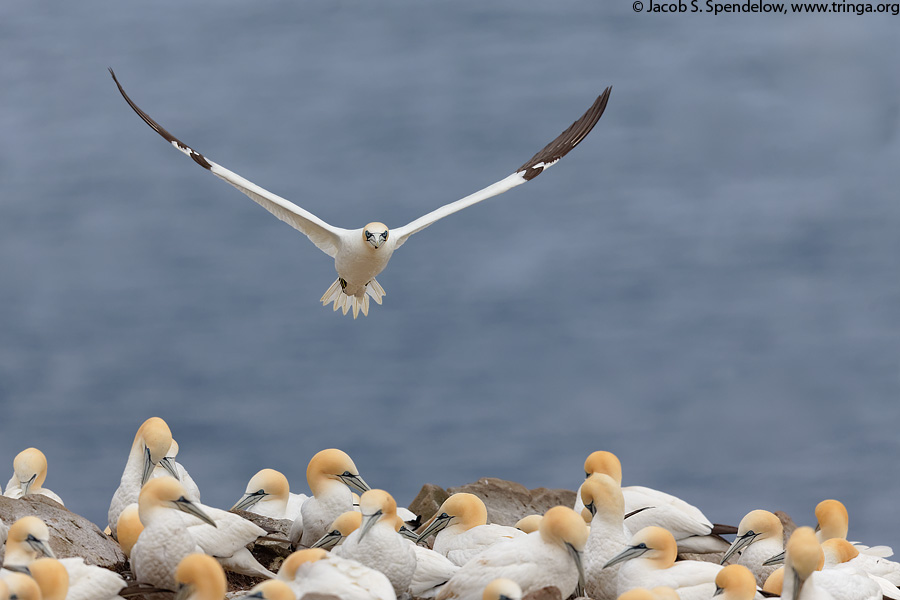
A Northern Gannet comes in for a landing on the crowded rock at Cape St. Mary's.
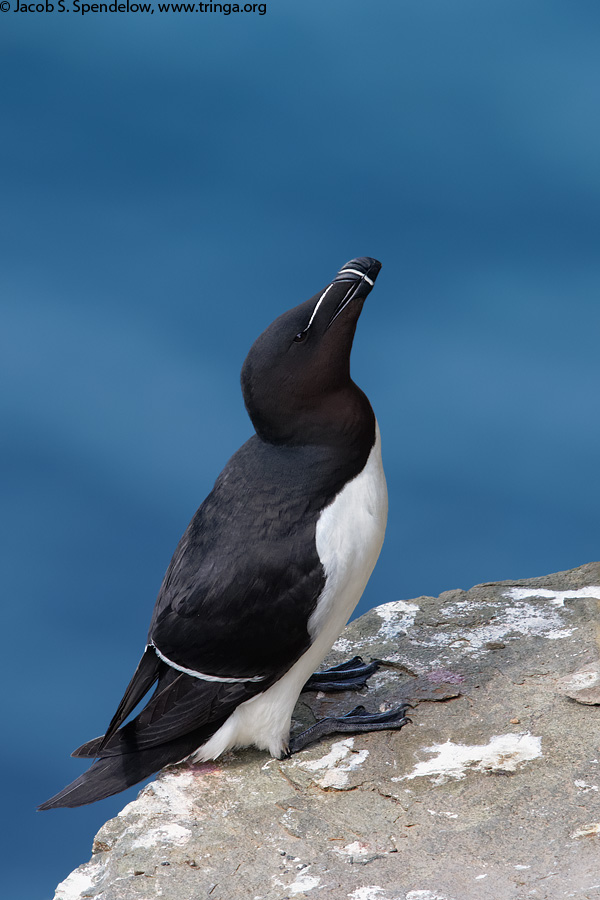
A Razorbill captured during a rare moment when the clouds broke up enough to get a blue ocean background.
While photographing seabirds at Cape St. Mary's was rather easy, seabird photography by kayak proved difficult. My kayak sessions off Vancouver Island in 2014 had given me an idea of how challenging it could be, but Newfoundland kayak photography was at another level of difficulty. I spent two afternoons photographing puffins, murres, and other seabirds by kayak at the Green Island colony, which required a lengthy paddle out, then a frustrating process of trying to photograph birds bobbing up and down on the waves while I myself was bobbing in swells that reached four feet at times, all while being pushed around by winds around ten knots. And the days I went out were relatively calm for the area! I took well over a thousand photos during those sessions and ended up with only seventeen that I deemed usable. I was really happy with a few of those photos, though, so I guess it was worth it. Photograpy aside, being out on the open ocean in the middle of all those seabirds was one of the most spectacular nature experiences of my life. The best moment came when something spooked the birds off the island, and all of a sudden I had thousands upon thousands of murres and puffins flying just overhead and all around me, almost blocking out the sky and drowning out the howling wind with the whirring of their wingbeats. An absolutely unforgettable experience.
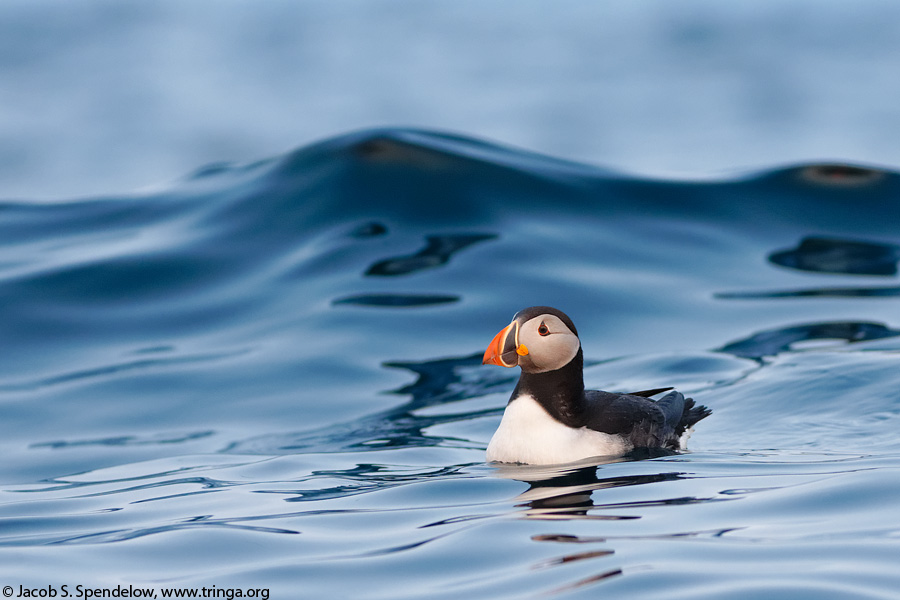
An Atlantic Puffin off the coast of Newfoundland.
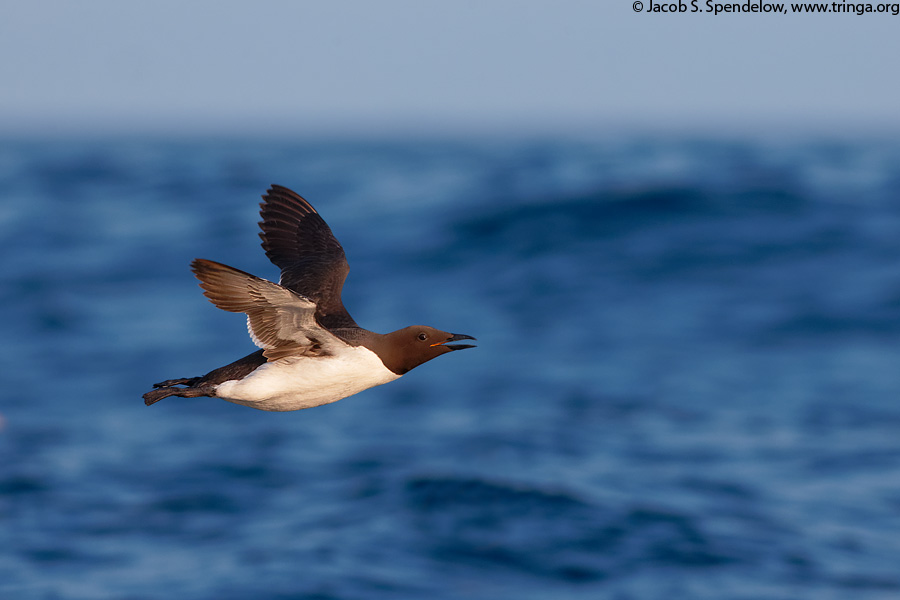
A Common Murre returning to the breeding colony at Green Island just before sunset. I was mostly trying to photograph alcids on the water, but I had better luck with birds in flight.
Seabirds were the main focus of my trip, but I also had some nice sessions with landbirds. The area around Cape St. Mary's has a fascinating landscape, with extensive tundra that holds breeding species like Horned Lark, American Pipit, and Savannah Sparrow. Reportedly there are even ptarmigans in the area, though I didn't see any. I did stumble upon a pair of ridiculously cute fledgling Horned Larks, though, and found that they consistently hung out in the same spot near the parking area. It was incredible to see how much they grew up over the course of just a few days.
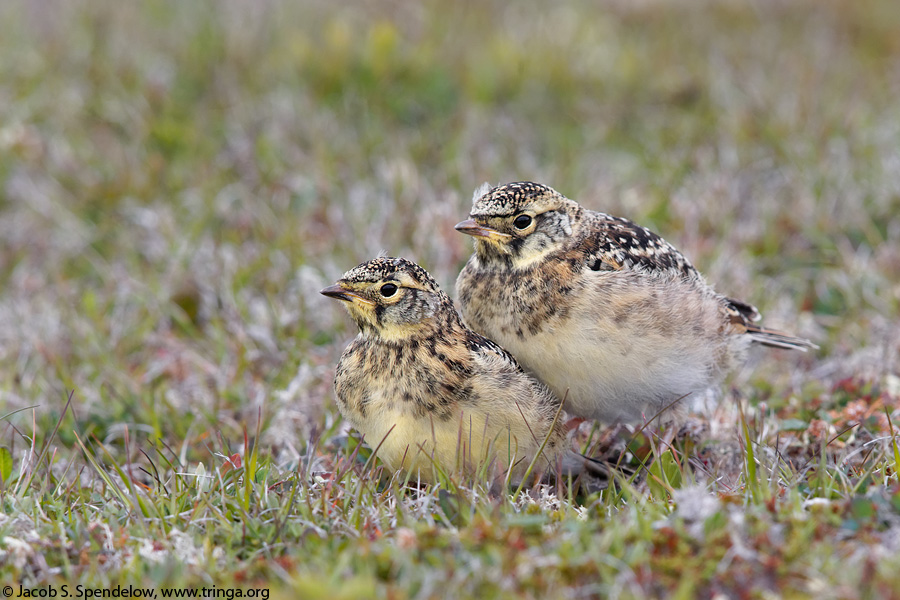
A pair of Horned Lark fledglings on the windswept tundra at Cape St. Mary's.
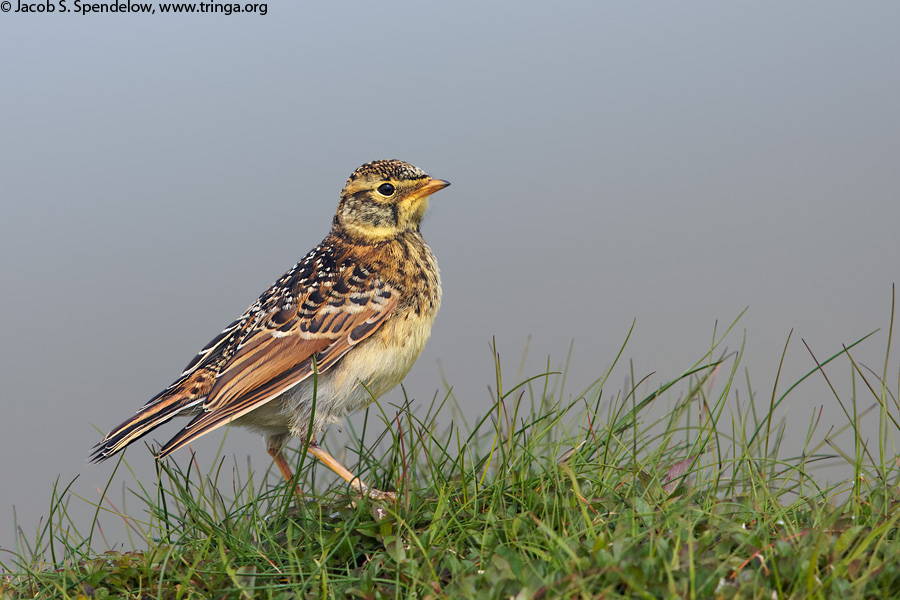
This is the larger fledgling from the photo above, photographed just two days later. How quickly they grow up!
I also spent some time in the inland boreal forests, which were generally quite similar to the forests I've visited in other parts of Canada and Alaska, and had mostly the same birds. The forests along the exposed coast had quite a different character, though. The persistent howling winds cause the spruce and fir trees in those forests to grow in stunted, tangled, bizarrely sculpted masses known locally as tuckamores. Despite looking nothing like a typical boreal forest, these tuckamores hosted mostly the same bird species as forests with trees five times taller. It was a strange sight to see birds like Yellow-bellied Flycatcher, which I've always associated with fairly tall trees, inhabiting woodlands where the tallest tree wasn't even ten feet.
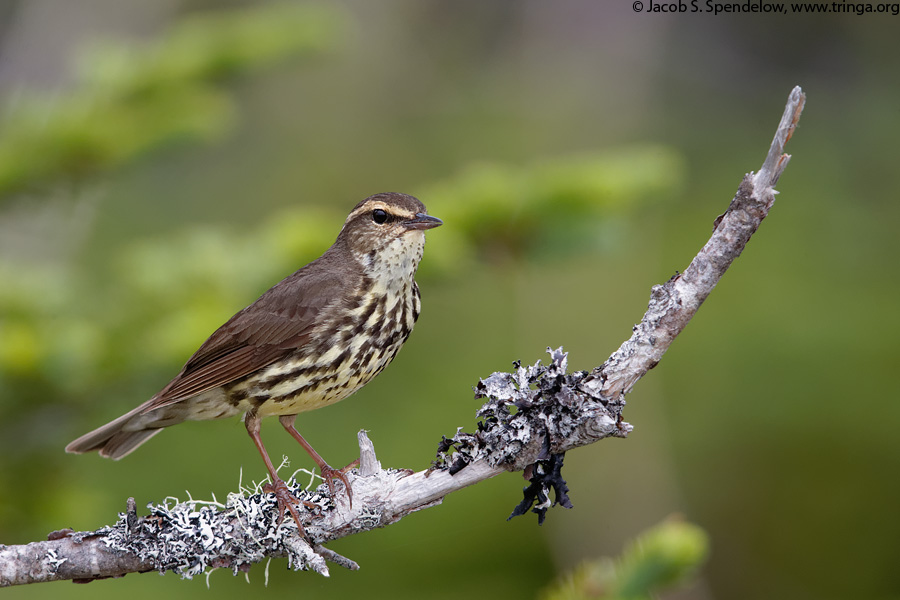
A Northern Waterthrush in a Newfoundland spruce forest. I'm quite familiar with this species as a migrant, but it was great getting to see them on their breeding grounds.
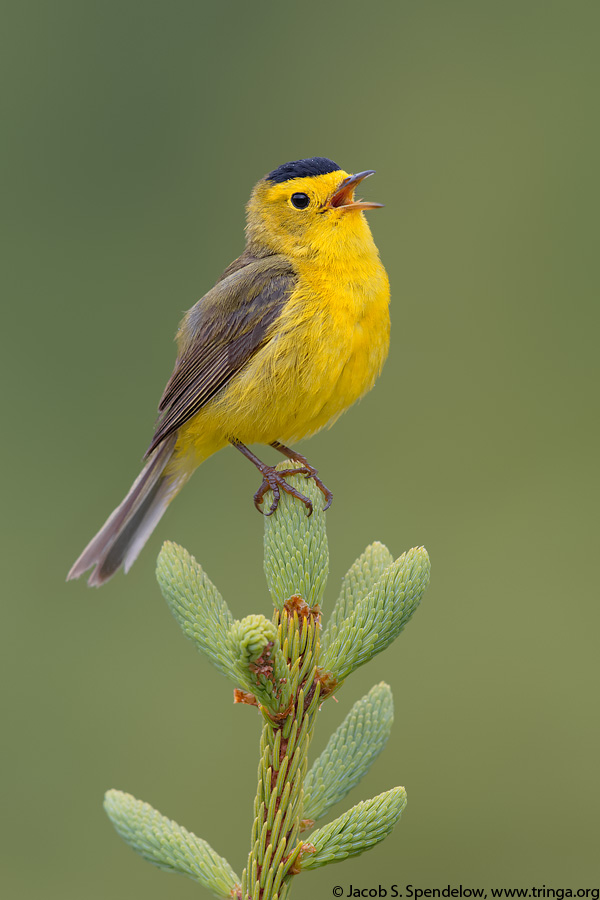
This dapper little Wilson's Warbler liked to sing from the very top of the spruce trees. Fortunately for me, the spruce trees in this area were only six feet tall!
More recently, I've been doing lots of local photography here in New Mexico, and also got to take a few pictures on recent trips to Costa Rica and England. Those photos should be posted here soon.